Bringing a dog into your home is a joyous experience, but for individuals with allergies, finding the right canine companion can be a challenge. The good news is that living with a dog doesn’t have to mean constant sniffles and itchy eyes. Many breeds are celebrated for their minimal shedding coats, making them ideal candidates for those seeking the best dog to get that doesn’t shed. These dogs are often referred to as “hypoallergenic,” a term that, while popular, warrants a deeper understanding.
This comprehensive guide will explore the truth behind non-shedding dogs, delve into the characteristics that make certain breeds more allergy-friendly, and introduce you to a diverse array of top breeds that produce significantly less dander and hair, helping you find your perfect furry match for a sneeze-free household. From tiny lapdogs to energetic giants, discover the unique qualities and care requirements of these exceptional companions.
Understanding “Non-Shedding” and “Hypoallergenic” Dogs
The terms “non-shedding” and “hypoallergenic” are often used interchangeably, but it’s important to clarify their meaning, especially when considering the best dog to get that doesn’t shed. While many breeds are known for their low-shedding coats, no dog is truly 100% allergen-free. The primary culprits behind dog allergies are not the hairs themselves, but proteins found in a dog’s dander (dead skin flakes), saliva, and urine. These allergens become airborne or attach to shed hair, spreading throughout the environment.
No Dog Is 100% Allergen-Free
Even breeds widely promoted as “hypoallergenic” still produce these allergens. What makes them better for allergy sufferers is their coat type, which typically sheds very little, if at all. This means fewer allergen-laden hairs are released into the home environment. Less shedding translates to less dander dispersion, which can significantly reduce allergic reactions for many sensitive individuals. Understanding this distinction is crucial when choosing a [type of dog that doesn’t shed] and setting realistic expectations.
What Causes Dog Allergies?
Dog allergies are an immune system response to proteins specific to canines. These proteins, primarily Can f 1, Can f 2, and Can f 5, are found in the dog’s dander, saliva, and urine. When these microscopic particles are inhaled or come into contact with skin, an allergic person’s immune system overreacts, producing symptoms like sneezing, runny nose, itchy eyes, skin rashes, or even asthma. While long hair might seem like the main issue, it’s the dander attached to the hair that is the primary trigger. Dogs with continuously growing hair, like Poodles, tend to shed less, thus retaining more dander within their coats rather than releasing it into the home.
Top Dog Breeds That Don’t Shed
When searching for the best dog to get that doesn’t shed, you’ll find a wide variety of breeds, each with its own charm, personality, and specific care needs. While the following breeds are renowned for their low-shedding qualities, remember that consistent grooming and home maintenance are still vital for managing allergens.
1. Poodle (Standard, Miniature, and Toy)
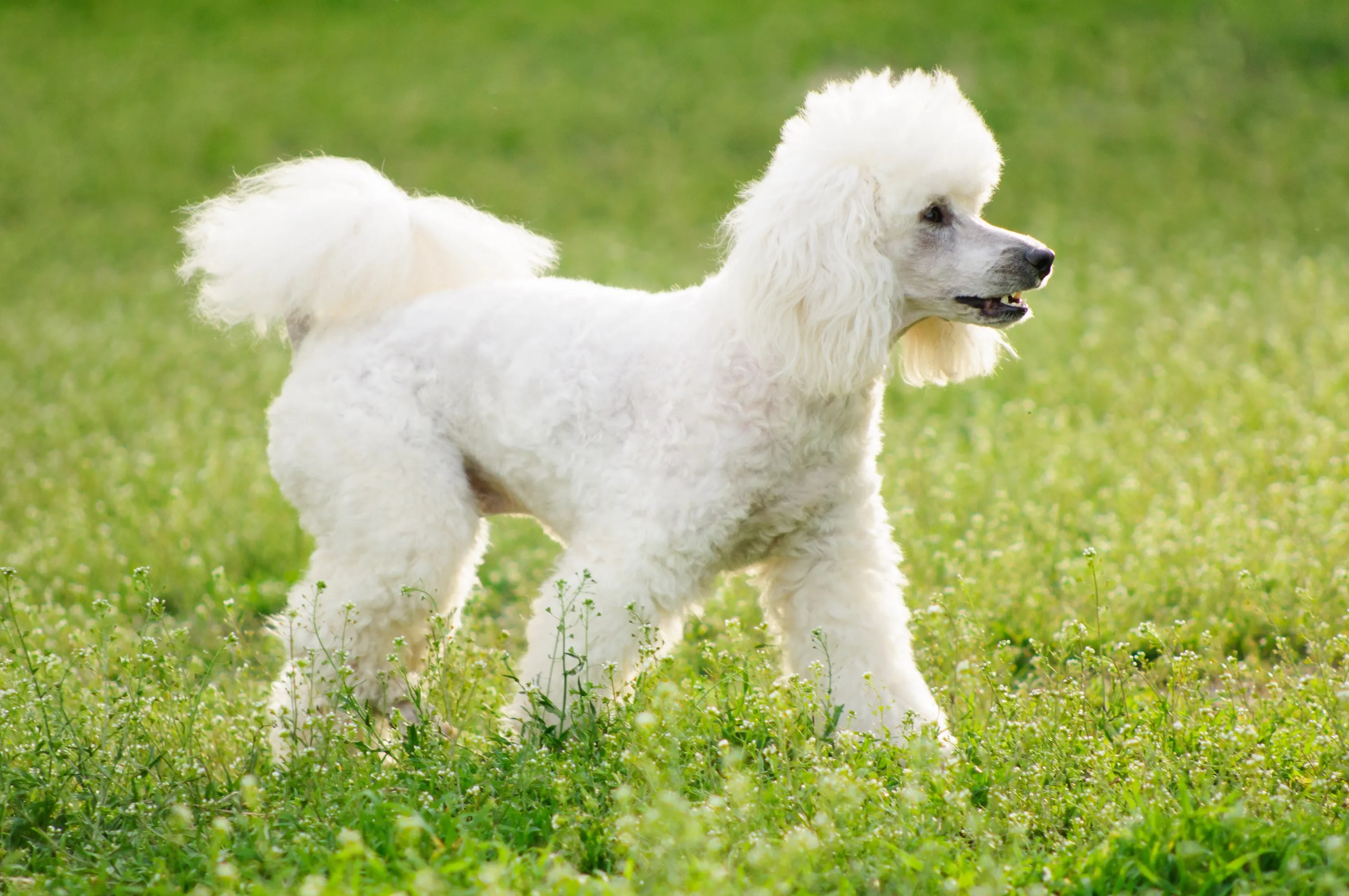 White Poodle walking through grassPoodles are perhaps the most famous of all low-shedding breeds, coming in three distinct sizes: Standard, Miniature, and Toy. Known for their exceptional intelligence and elegant, curly coats, Poodles shed minimally, making them a popular choice for allergy sufferers. Their dense, woolly coat is more akin to human hair, growing continuously and trapping dander rather than releasing it.
White Poodle walking through grassPoodles are perhaps the most famous of all low-shedding breeds, coming in three distinct sizes: Standard, Miniature, and Toy. Known for their exceptional intelligence and elegant, curly coats, Poodles shed minimally, making them a popular choice for allergy sufferers. Their dense, woolly coat is more akin to human hair, growing continuously and trapping dander rather than releasing it.
Key Characteristics: Highly intelligent, active, and trainable. Poodles are versatile companions, excelling in various dog sports and making wonderful family pets.
Grooming Requirements: Despite their low shedding, Poodles require significant grooming. Regular brushing (daily to every other day) is essential to prevent matting, and professional grooming every 4-6 weeks is necessary to keep their coats trimmed and healthy.
Suitability: Adaptable to various living situations, from apartments (Toy/Miniature) to homes with yards (Standard). They thrive on mental stimulation and physical exercise.
2. Yorkshire Terrier
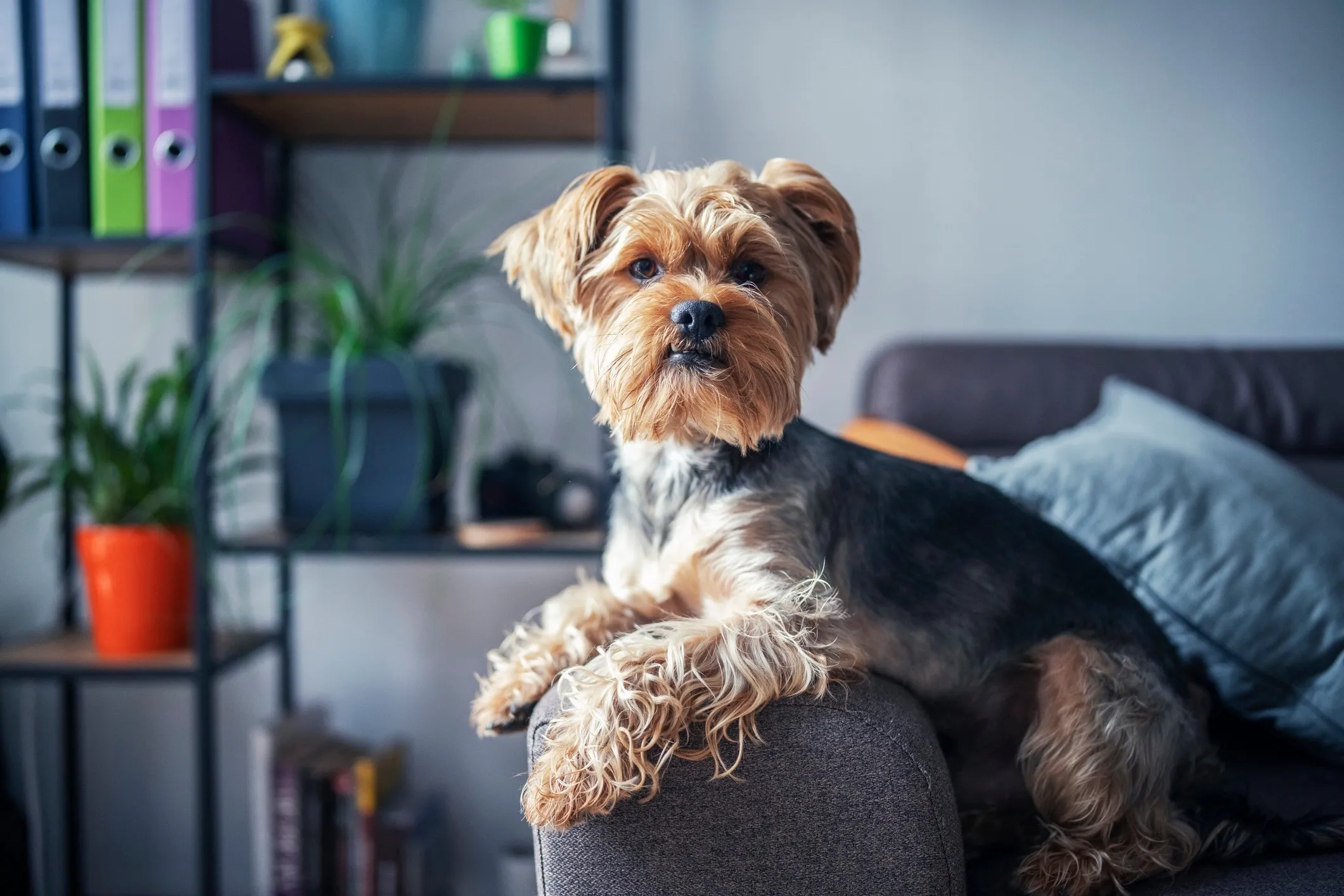 Blue and tan Yorkie lounging on an armchairTiny in stature but big in personality, the Yorkshire Terrier is a spunky and affectionate companion that boasts a silky, human-like coat that sheds very little. Their long, fine hair requires diligent care to prevent tangles and maintain its lustrous appearance.
Blue and tan Yorkie lounging on an armchairTiny in stature but big in personality, the Yorkshire Terrier is a spunky and affectionate companion that boasts a silky, human-like coat that sheds very little. Their long, fine hair requires diligent care to prevent tangles and maintain its lustrous appearance.
Key Characteristics: Bold, confident, and often feisty, but deeply devoted to their families. Yorkies are surprisingly adaptable to city living.
Grooming Requirements: Daily brushing is crucial to prevent matting of their long coats. Many owners opt for a “puppy cut” to make grooming more manageable. Regular bathing and professional trimming are also recommended.
Suitability: Excellent for apartment dwellers and those seeking a devoted lapdog. They need early socialization to ensure they get along well with children and other pets.
3. Shih Tzu
 Brown and white Shih Tzu lying on a living room floorOriginating from Tibet, the Shih Tzu is an ancient companion breed renowned for its lush, flowing double coat and friendly, outgoing temperament. Despite their abundance of hair, Shih Tzus are considered low-shedding, with most loose hair caught within their long coat.
Brown and white Shih Tzu lying on a living room floorOriginating from Tibet, the Shih Tzu is an ancient companion breed renowned for its lush, flowing double coat and friendly, outgoing temperament. Despite their abundance of hair, Shih Tzus are considered low-shedding, with most loose hair caught within their long coat.
Key Characteristics: Affectionate, playful, and charming. They are bred purely for companionship and thrive on human interaction.
Grooming Requirements: Their long coat needs daily brushing to avoid mats. Professional grooming every 4-6 weeks is often necessary, especially for their distinctive facial hair which can lead to tear stains if not managed. Owners often opt for shorter cuts for easier maintenance.
Health Considerations: Due to their brachycephalic (flat) faces, Shih Tzus can be prone to breathing issues and overheating, especially in warm weather.
Suitability: Perfect for families and seniors, they adapt well to apartment living and do not require extensive exercise.
4. Miniature Schnauzer
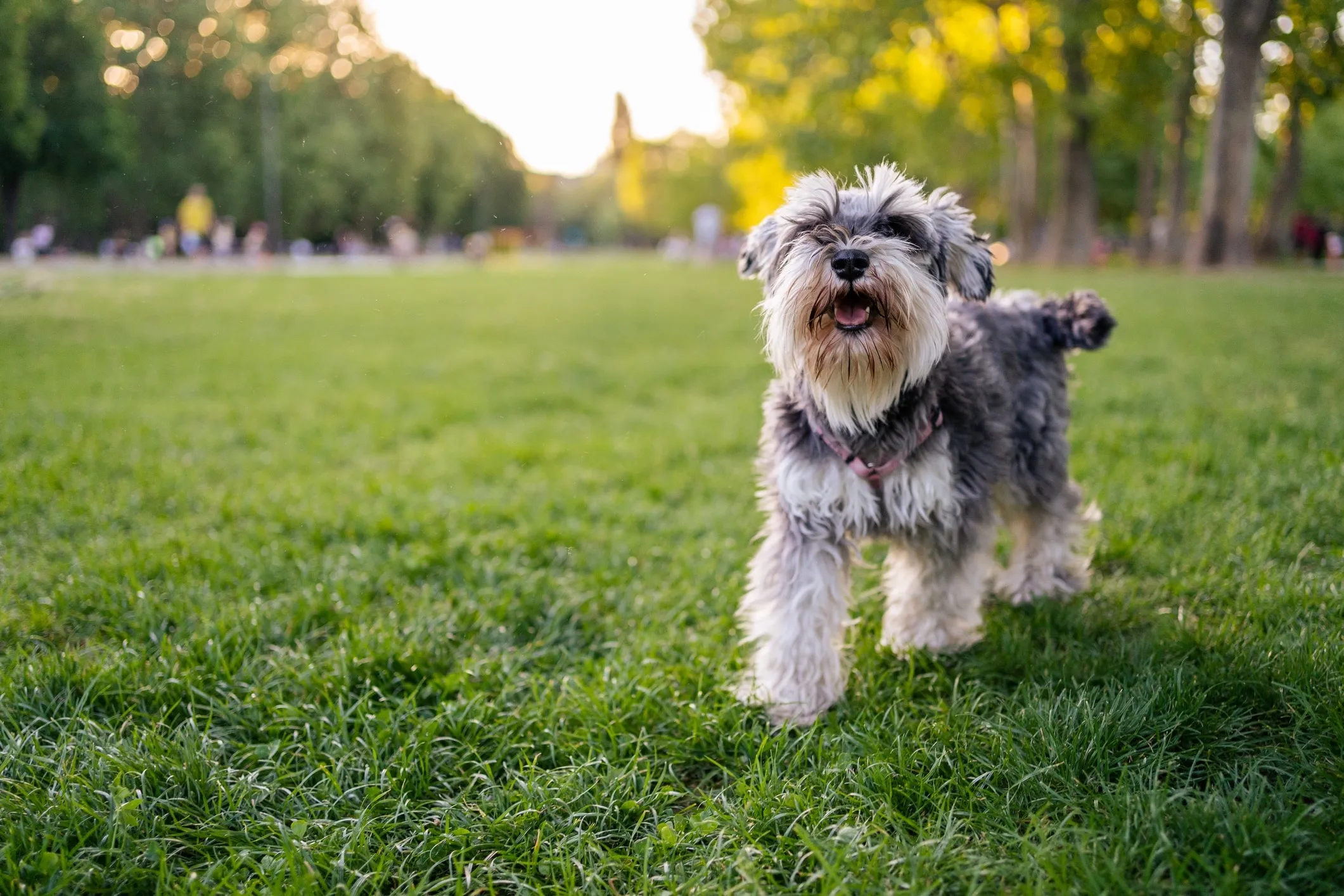 Salt and pepper Miniature Schnauzer wearing a pink harness in a parkThe Miniature Schnauzer is the smallest of the three Schnauzer breeds, known for its distinctive wiry coat, bushy eyebrows, and beard. This breed sheds minimally, making it a popular choice for those looking for a [family dog breeds that don’t shed].
Salt and pepper Miniature Schnauzer wearing a pink harness in a parkThe Miniature Schnauzer is the smallest of the three Schnauzer breeds, known for its distinctive wiry coat, bushy eyebrows, and beard. This breed sheds minimally, making it a popular choice for those looking for a [family dog breeds that don’t shed].
Key Characteristics: Intelligent, alert, and spirited. Miniature Schnauzers are surprisingly robust and make excellent watchdogs. They are loyal and loving with their families.
Grooming Requirements: Their wiry coat requires regular brushing, professional clipping every 5-8 weeks, or hand-stripping to maintain its texture and low-shedding qualities.
Suitability: Adaptable to various living environments, including apartments, provided they receive at least an hour of daily exercise and mental stimulation.
5. Standard Schnauzer
 Gray Standard Schnauzer standing in a fieldThe Standard Schnauzer is a larger version of its miniature counterpart, sharing the same low-shedding, wiry coat and intelligent nature. These dogs are robust and active, needing plenty of engagement.
Gray Standard Schnauzer standing in a fieldThe Standard Schnauzer is a larger version of its miniature counterpart, sharing the same low-shedding, wiry coat and intelligent nature. These dogs are robust and active, needing plenty of engagement.
Key Characteristics: Strong-willed, intelligent, and protective. Standard Schnauzers are versatile working dogs that thrive on having a job to do. They are devoted to their families but can be reserved with strangers.
Grooming Requirements: Similar to the Miniature Schnauzer, they require regular brushing and professional grooming (clipping or hand-stripping).
Suitability: Best suited for active families who can provide ample exercise and consistent training. They require mental challenges through activities like fetch or puzzle toys.
6. Giant Schnauzer
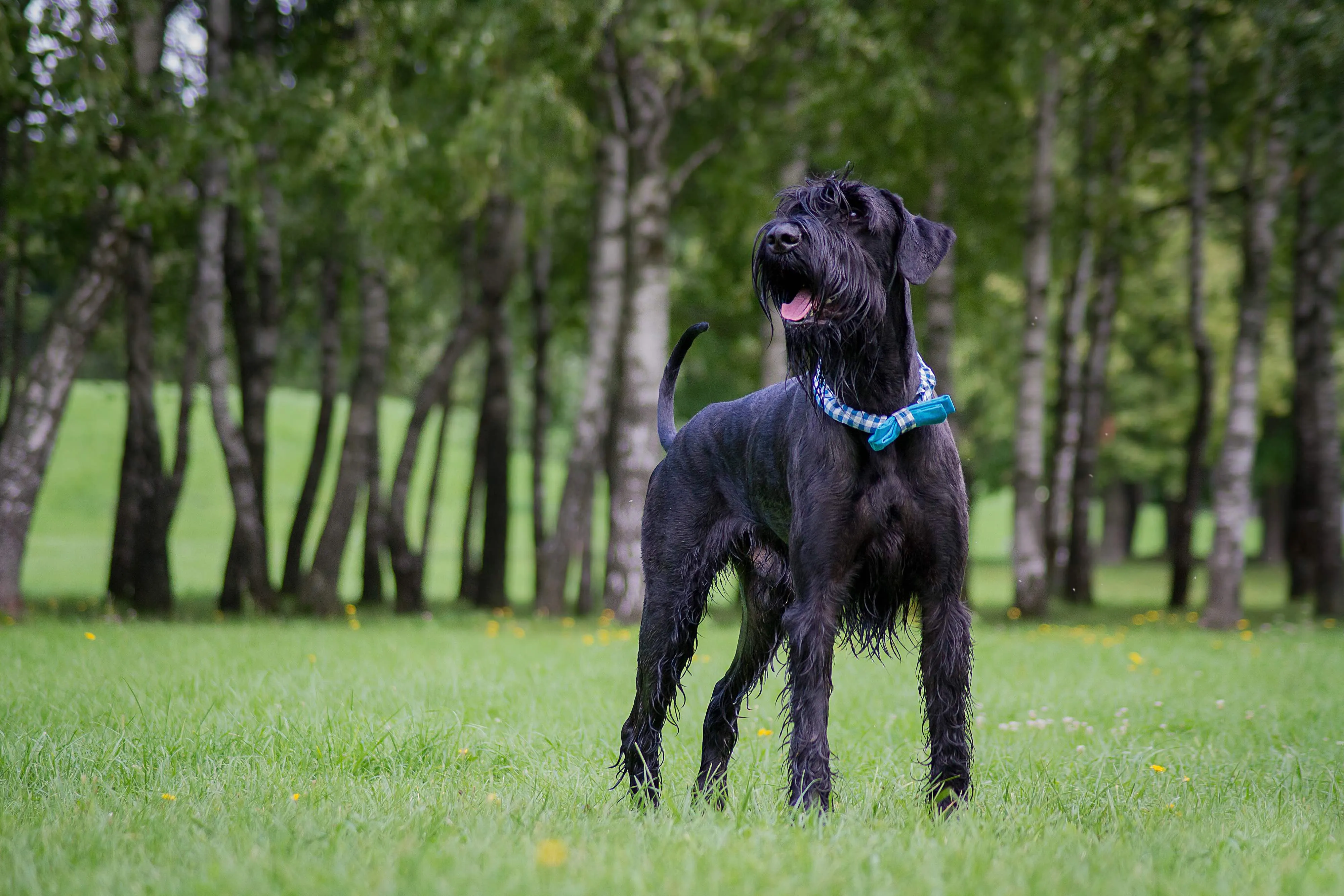 Black wet Giant Schnauzer wearing a blue bow collar standing in a parkAs the largest of the Schnauzer trio, the Giant Schnauzer is an impressive and powerful breed. Despite their size, their wiry coat contributes to their status as one of the best dog to get that doesn’t shed for those seeking a larger, protective companion.
Black wet Giant Schnauzer wearing a blue bow collar standing in a parkAs the largest of the Schnauzer trio, the Giant Schnauzer is an impressive and powerful breed. Despite their size, their wiry coat contributes to their status as one of the best dog to get that doesn’t shed for those seeking a larger, protective companion.
Key Characteristics: Loyal, protective, and commanding. Giant Schnauzers are intelligent and capable working dogs that require experienced owners who can provide strong leadership and extensive training. They can be [protective dog breeds that don t shed].
Grooming Requirements: Regular brushing and professional grooming are essential to prevent matting and maintain their distinguished appearance.
Suitability: Best for experienced owners in active households with ample space. They need significant daily exercise and mental challenges to prevent boredom and destructive behaviors.
7. Bichon Frise
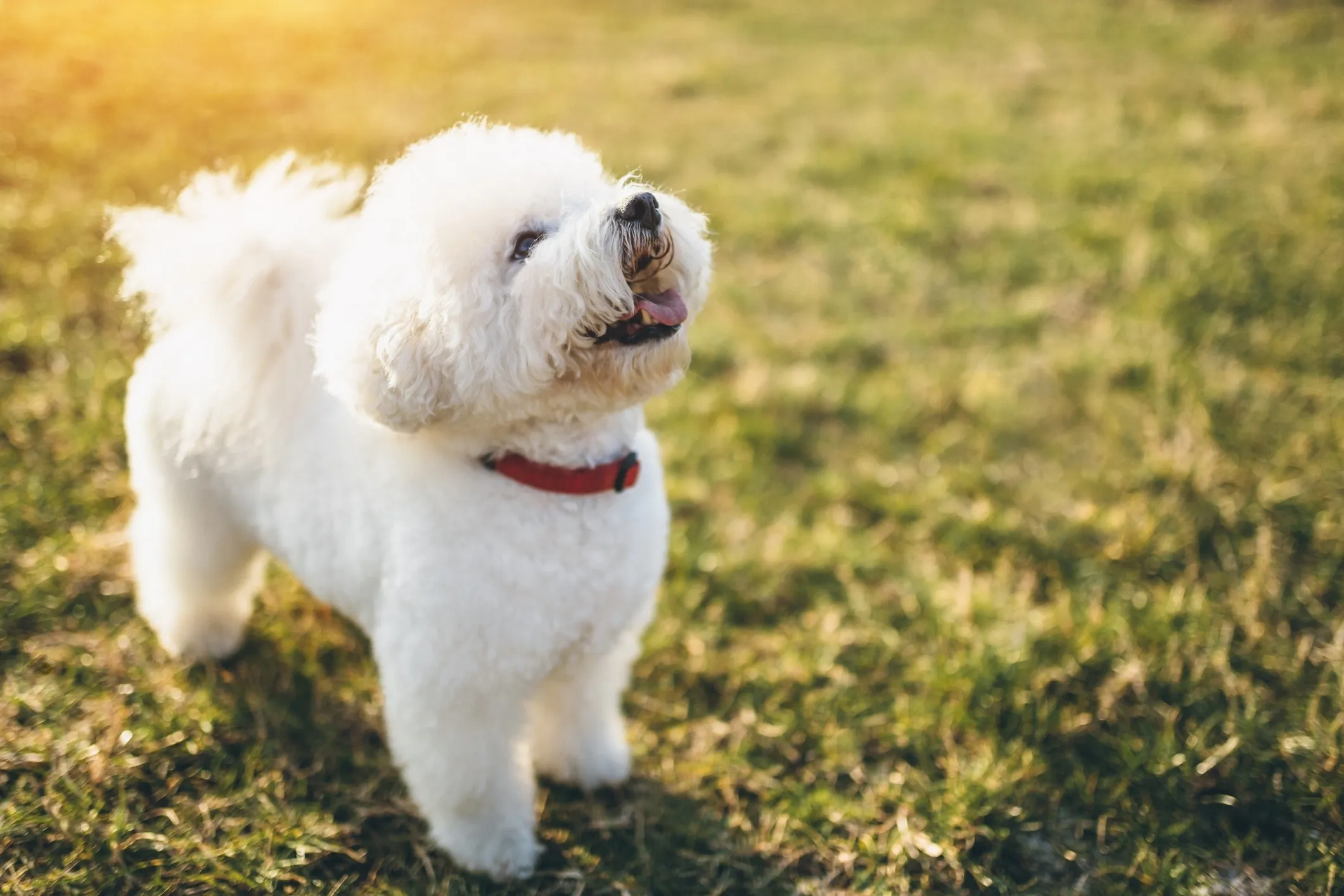 White Bichon Frise dog looking up in the grassThe Bichon Frise is a small, cheerful dog with a fluffy, curly white coat that sheds very little. Their playful and affectionate nature, combined with their low-shedding coat, makes them a delightful choice for many families.
White Bichon Frise dog looking up in the grassThe Bichon Frise is a small, cheerful dog with a fluffy, curly white coat that sheds very little. Their playful and affectionate nature, combined with their low-shedding coat, makes them a delightful choice for many families.
Key Characteristics: Vivacious, charming, and gentle. Bichons are highly trainable and love to entertain their families with tricks and games.
Grooming Requirements: Daily brushing is necessary to prevent their soft double coat from matting. Professional grooming every 4-6 weeks is also required to maintain their shape and cleanliness.
Suitability: Ideal for apartment living and families, including those with children and other pets, as they are generally very social and adaptable.
8. Chinese Crested (Hairless & Powderpuff)
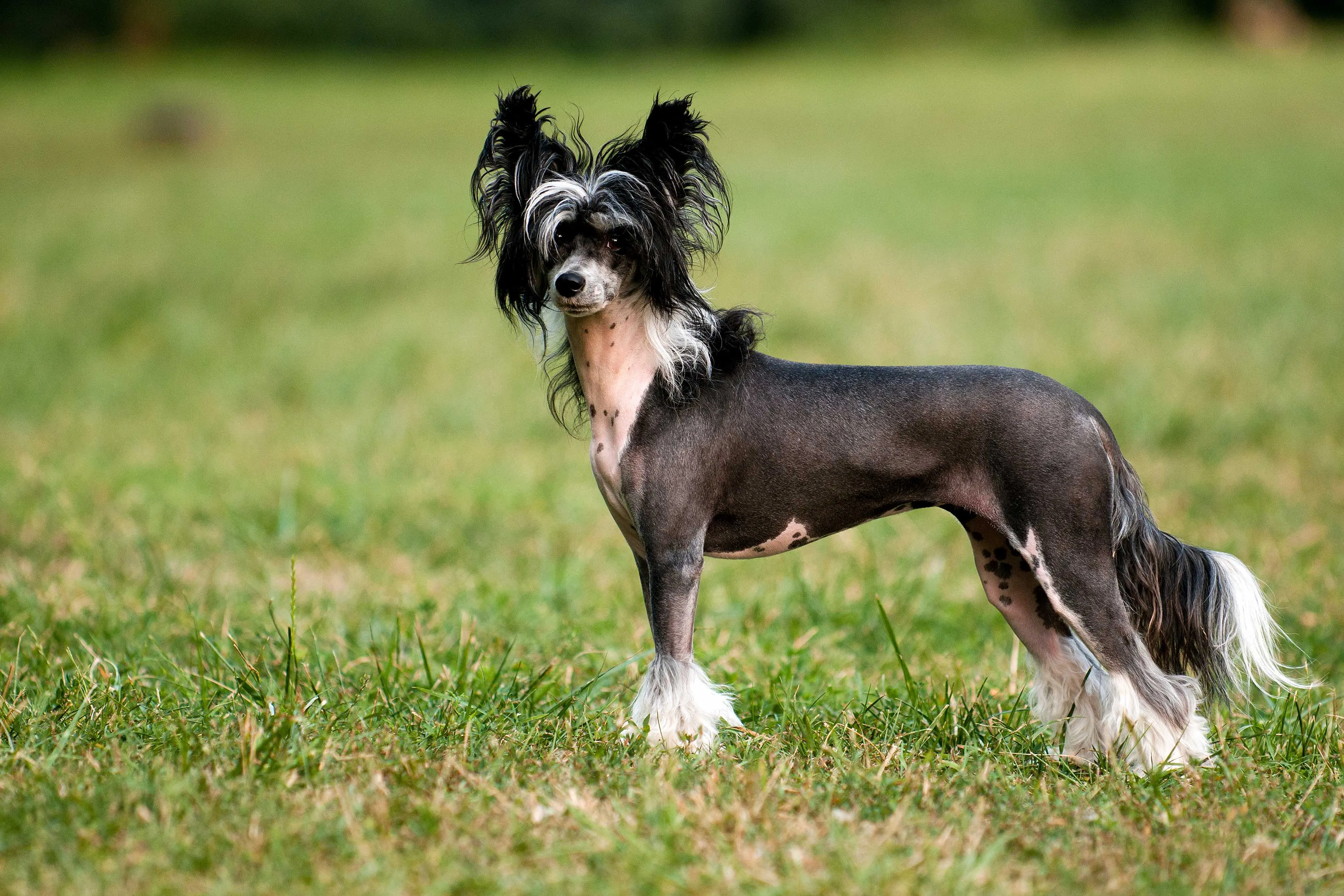 Black hairless Chinese Crested looking at the cameraThe Chinese Crested is a unique breed known for its two distinct varieties: the hairless, with smooth skin and tufts of hair on the head, tail, and paws, and the “Powderpuff,” which has a full, soft coat. Both varieties are considered low-shedding.
Black hairless Chinese Crested looking at the cameraThe Chinese Crested is a unique breed known for its two distinct varieties: the hairless, with smooth skin and tufts of hair on the head, tail, and paws, and the “Powderpuff,” which has a full, soft coat. Both varieties are considered low-shedding.
Key Characteristics: Affectionate, playful, and charming. They form strong bonds with their owners and enjoy being lapdogs.
Grooming Requirements: Hairless Cresteds need skin care (sunscreen, moisturizer, occasional bathing) to protect their delicate skin. Powderpuffs require regular brushing to prevent tangles in their soft double coat.
Suitability: Excellent for apartment living and individuals seeking a unique, devoted companion. Their small size makes them fragile, so care is needed around young children.
9. Portuguese Water Dog
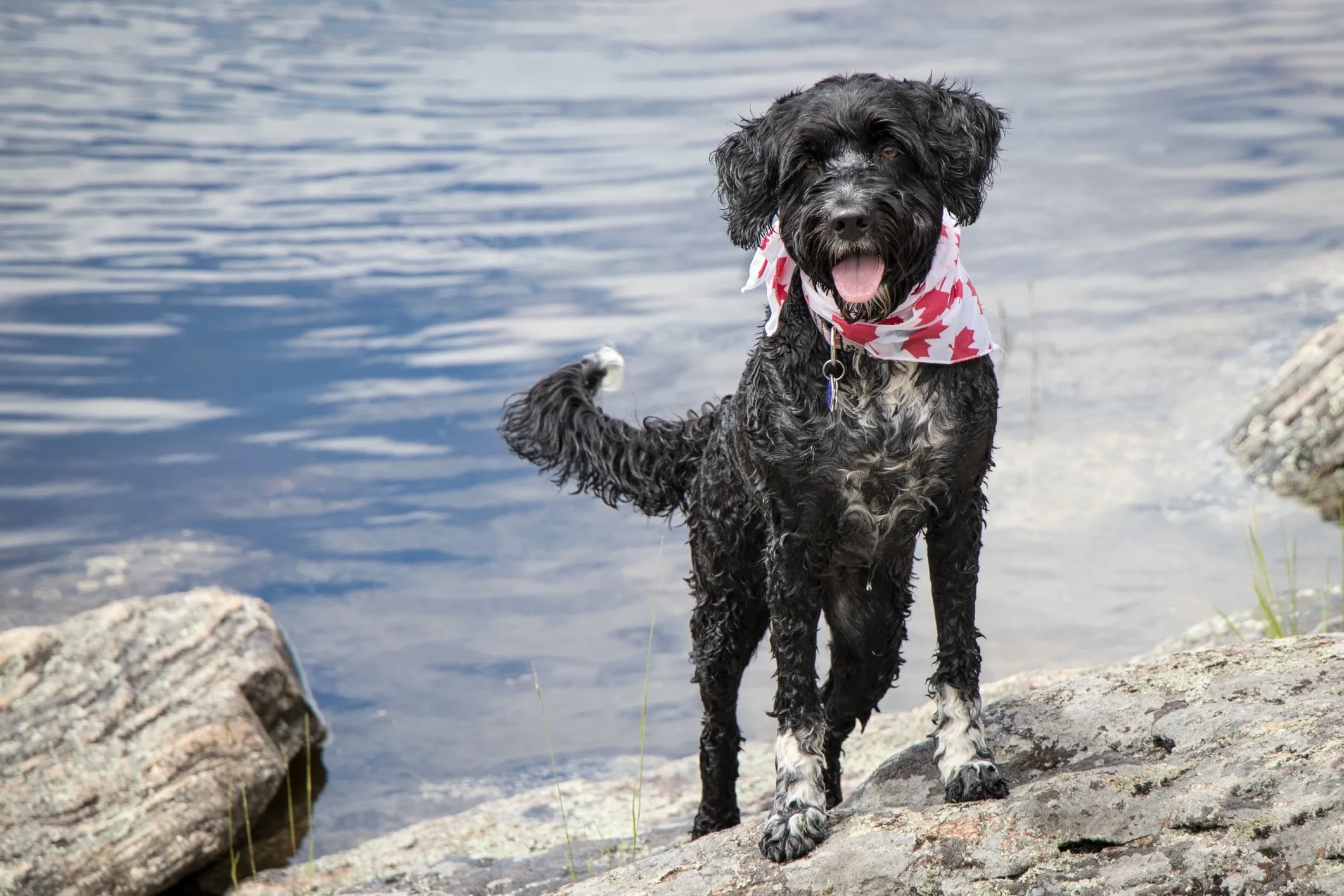 Black and white Portuguese Water Dog wearing a red maple leaf bandana in front of waterOriginally bred to assist fishermen, the Portuguese Water Dog is a robust, athletic, medium-sized breed with a wavy or curly coat that sheds very little. Their water-loving nature and intelligent disposition make them engaging companions.
Black and white Portuguese Water Dog wearing a red maple leaf bandana in front of waterOriginally bred to assist fishermen, the Portuguese Water Dog is a robust, athletic, medium-sized breed with a wavy or curly coat that sheds very little. Their water-loving nature and intelligent disposition make them engaging companions.
Key Characteristics: Intelligent, adventurous, and spirited. Portuguese Water Dogs are highly trainable and thrive on having a job to do, often excelling in dog sports.
Grooming Requirements: Regular brushing (several times a week) and professional grooming every 6-8 weeks are necessary to prevent matting of their continuously growing coat.
Suitability: Best suited for active families or individuals who can provide abundant exercise, mental stimulation, and opportunities for swimming. They make excellent adventure buddies.
10. Labradoodle
 Brown Standard Labradoodle walking in a parkA popular crossbreed between a Labrador Retriever and a Poodle, the Labradoodle was originally developed as a hypoallergenic service dog. They inherit the friendly nature of the Labrador and the low-shedding coat of the Poodle, making them one of the best dog to get that doesn’t shed for families.
Brown Standard Labradoodle walking in a parkA popular crossbreed between a Labrador Retriever and a Poodle, the Labradoodle was originally developed as a hypoallergenic service dog. They inherit the friendly nature of the Labrador and the low-shedding coat of the Poodle, making them one of the best dog to get that doesn’t shed for families.
Key Characteristics: Intelligent, friendly, and gentle. Labradoodles are excellent family pets, known for their affectionate nature and trainability.
Grooming Requirements: Their coat can vary from wavy to curly and requires regular brushing (2-3 times a week) to prevent matting, along with professional grooming every 6-8 weeks.
Suitability: Great for active families, they need moderate exercise and mental engagement. Early socialization is crucial to foster their gentle demeanor.
11. Goldendoodle
 Goldendoodle lying on a couch with a person sitting in the backgroundAnother beloved “doodle” breed, the Goldendoodle is a cross between a Golden Retriever and a Poodle. They share many traits with the Labradoodle, including a low-shedding coat, friendly disposition, and high intelligence.
Goldendoodle lying on a couch with a person sitting in the backgroundAnother beloved “doodle” breed, the Goldendoodle is a cross between a Golden Retriever and a Poodle. They share many traits with the Labradoodle, including a low-shedding coat, friendly disposition, and high intelligence.
Key Characteristics: Affectionate, playful, and intelligent. Goldendoodles are known for their easygoing nature and make wonderful family companions.
Grooming Requirements: Similar to Labradoodles, their coats require frequent brushing (several times a week) with a slicker brush and professional grooming every 6-8 weeks to prevent mats.
Suitability: Highly adaptable, they thrive in active households and enjoy being involved in family activities. They need regular exercise and mental stimulation.
12. Lagotto Romagnolo
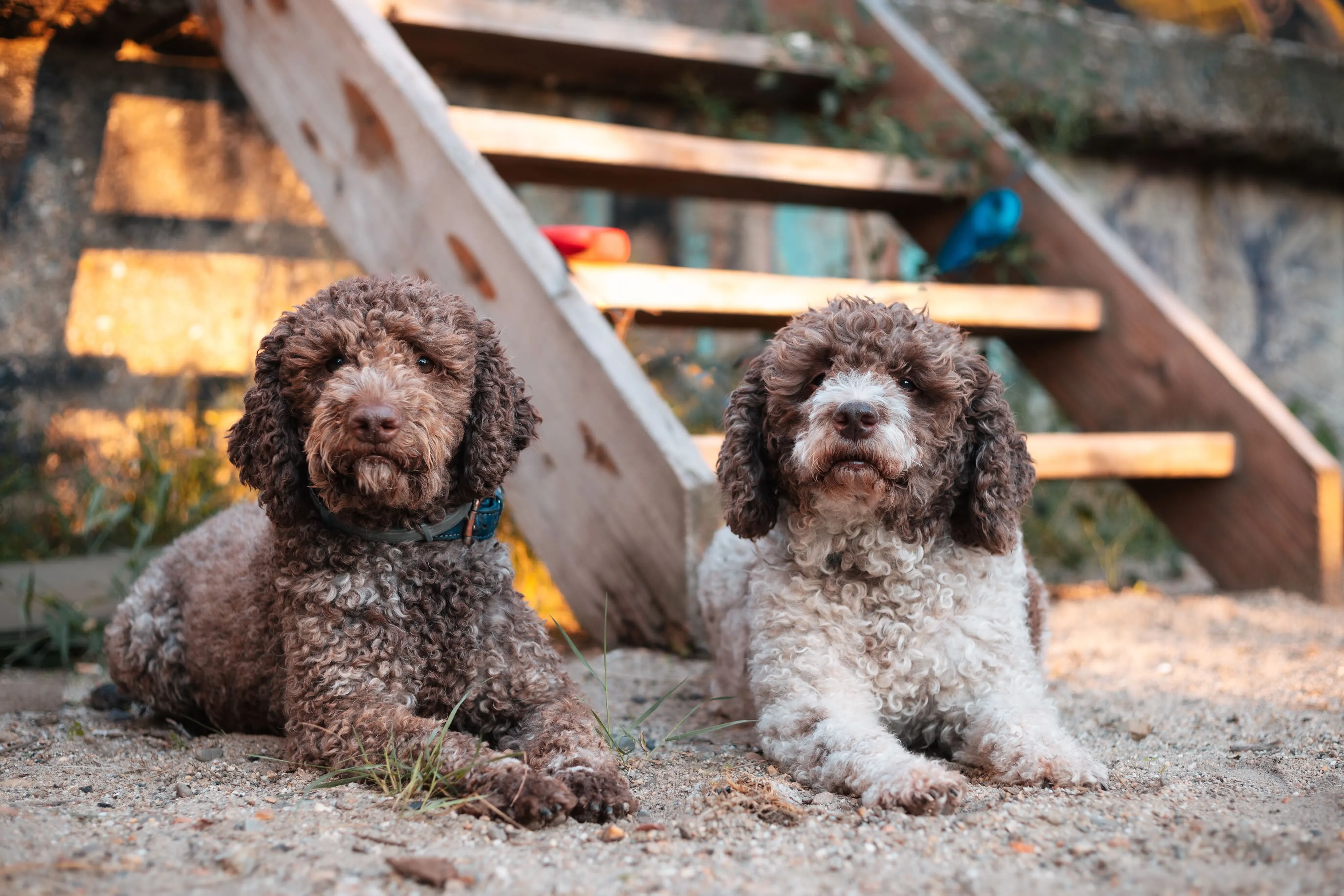 Two Lagotto Romagnolo dogs lying in dirt staring at the cameraHailing from Italy, the Lagotto Romagnolo is an ancient water retriever, specifically known for truffle hunting. Their dense, curly, woolly coat protects them from cold water and sheds minimally.
Two Lagotto Romagnolo dogs lying in dirt staring at the cameraHailing from Italy, the Lagotto Romagnolo is an ancient water retriever, specifically known for truffle hunting. Their dense, curly, woolly coat protects them from cold water and sheds minimally.
Key Characteristics: Intelligent, loyal, and enthusiastic. Lagotti Romagnoli are eager to please and enjoy having a “job” to do. They are generally good with children and other pets.
Grooming Requirements: Their curly coat needs regular brushing to prevent felting and matting, and professional clipping every few months.
Suitability: Best for active families who can provide mental challenges and opportunities for exercise, especially activities that engage their keen sense of smell.
13. Affenpinscher
 Black Affenpinscher dog close-upThe Affenpinscher is a small, terrier-like dog with a distinctive monkey-like face. Their dense, wiry coat sheds little and contributes to their classification as a low-allergen breed.
Black Affenpinscher dog close-upThe Affenpinscher is a small, terrier-like dog with a distinctive monkey-like face. Their dense, wiry coat sheds little and contributes to their classification as a low-allergen breed.
Key Characteristics: Curious, playful, and a bit mischievous. Affenpinschers are loyal to their owners but can be wary of strangers.
Grooming Requirements: Their wiry coat requires regular brushing and occasional hand-stripping (removal of dead hair by the root) to maintain its texture and low-shedding quality.
Suitability: Good for apartment living and individuals seeking a small, engaging companion. They benefit from early socialization.
14. Irish Water Spaniel
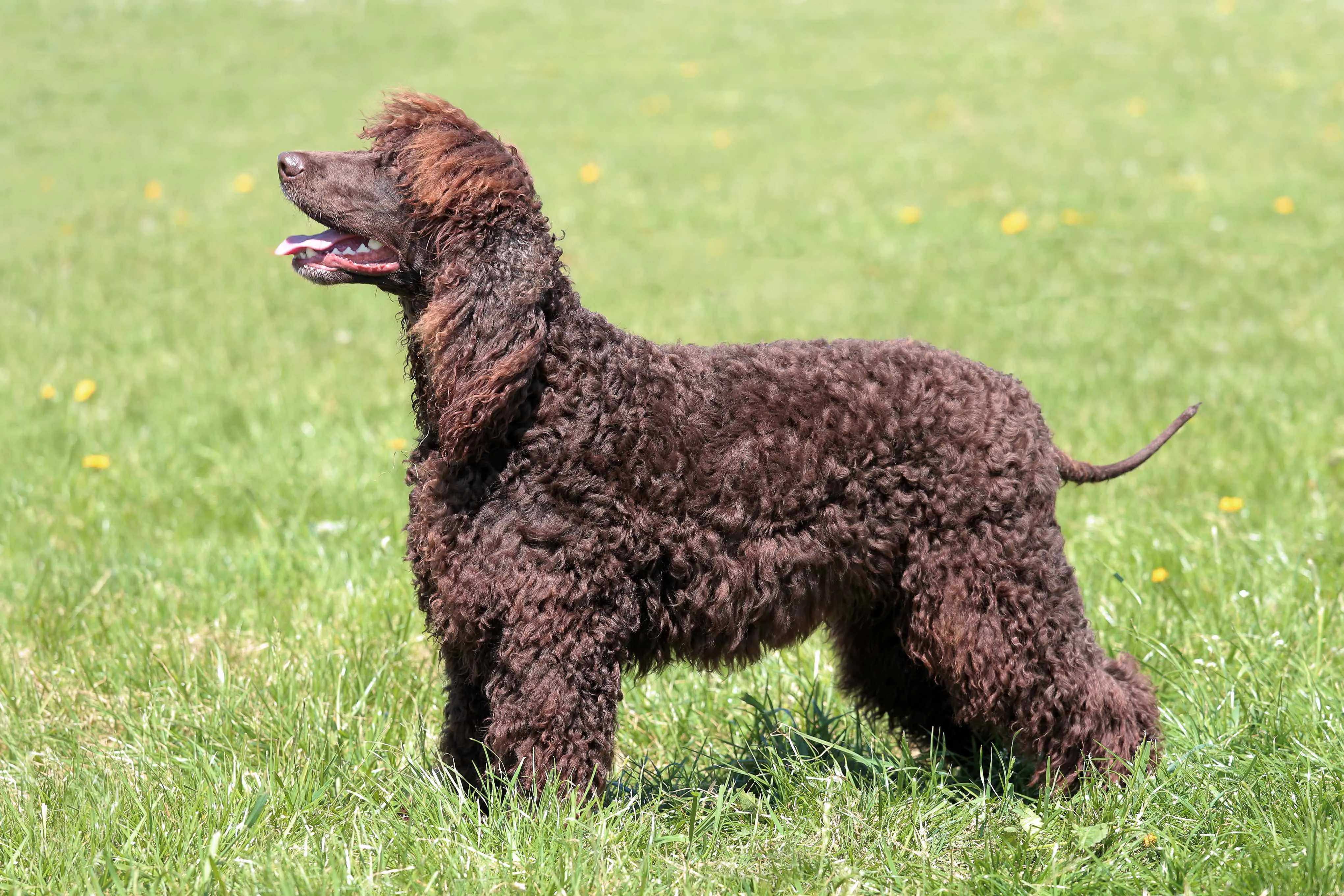 Brown Irish Water Spaniel profileKnown for their “rat tail” and dense, crisp, liver-colored curls, the Irish Water Spaniel is another excellent choice for those seeking a [type of dog that doesn’t shed]. These intelligent and friendly dogs were originally bred for retrieving game from water.
Brown Irish Water Spaniel profileKnown for their “rat tail” and dense, crisp, liver-colored curls, the Irish Water Spaniel is another excellent choice for those seeking a [type of dog that doesn’t shed]. These intelligent and friendly dogs were originally bred for retrieving game from water.
Key Characteristics: Energetic, intelligent, and humorous. They are highly trainable and excel in various dog sports, especially those involving water.
Grooming Requirements: Regular brushing is needed to prevent mats, and professional grooming (clipping) every 6-8 weeks is typical to keep their coat tidy.
Suitability: Requires a very active family or individual who can provide extensive exercise and mental stimulation. They thrive when they have a purpose.
15. Aussiedoodle
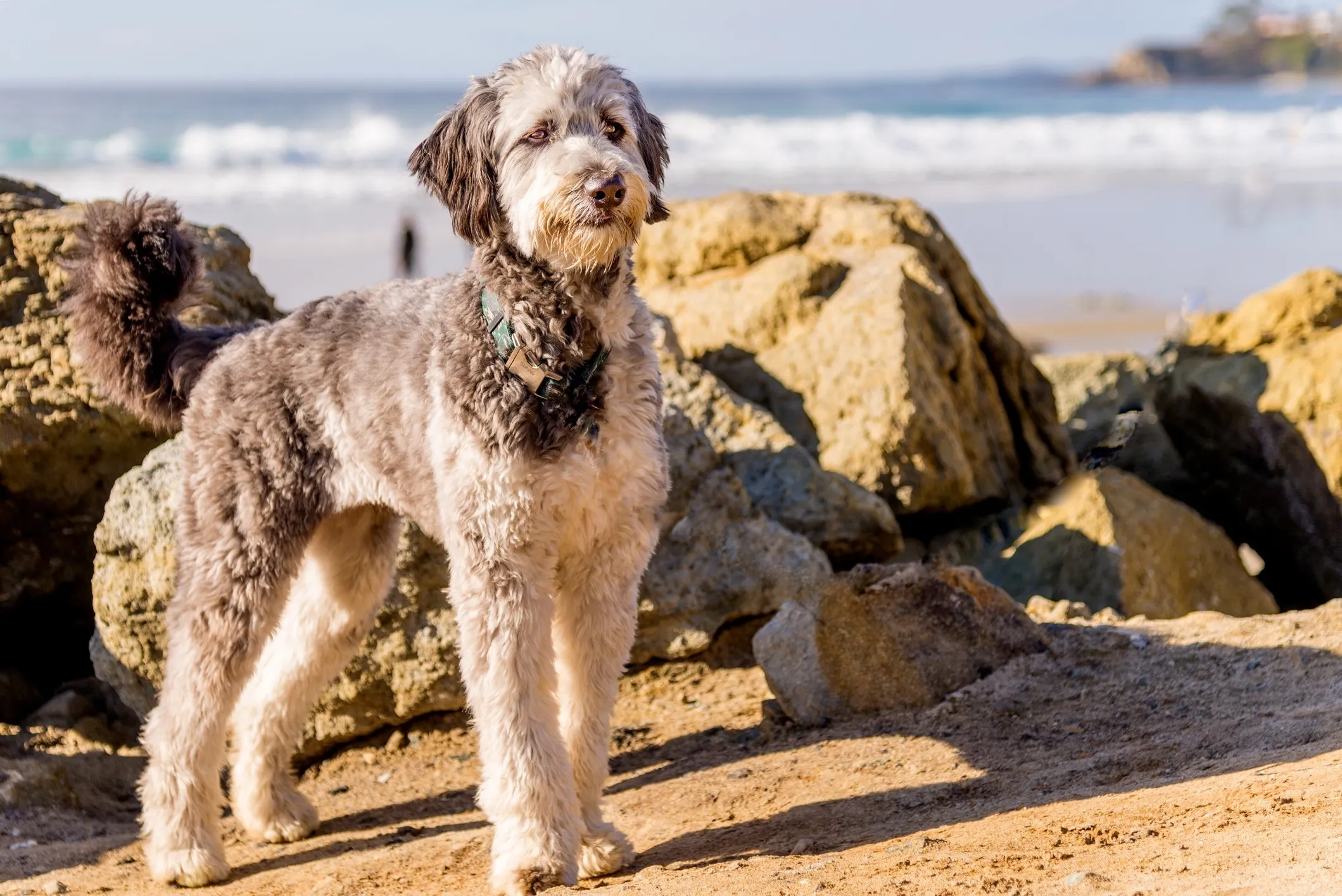 Standard Aussiedoodle dog standing on a beachA cross between an Australian Shepherd and a Poodle, the Aussiedoodle is a highly intelligent and energetic low-shedding breed. They combine the keen mind of the Aussie with the Poodle’s trainability and coat characteristics.
Standard Aussiedoodle dog standing on a beachA cross between an Australian Shepherd and a Poodle, the Aussiedoodle is a highly intelligent and energetic low-shedding breed. They combine the keen mind of the Aussie with the Poodle’s trainability and coat characteristics.
Key Characteristics: Smart, energetic, and eager to please. Aussiedoodles are adaptable but thrive on mental and physical challenges.
Grooming Requirements: Their coat, which can vary in texture, requires regular brushing (2-3 times a week) and professional grooming to prevent matting.
Suitability: Best for active families who can commit to significant exercise and consistent training. They need enrichment toys and activities to prevent boredom and destructive behaviors. This breed is one of the [dog breeds that dont shed too much] but requires attention.
16. Bolognese
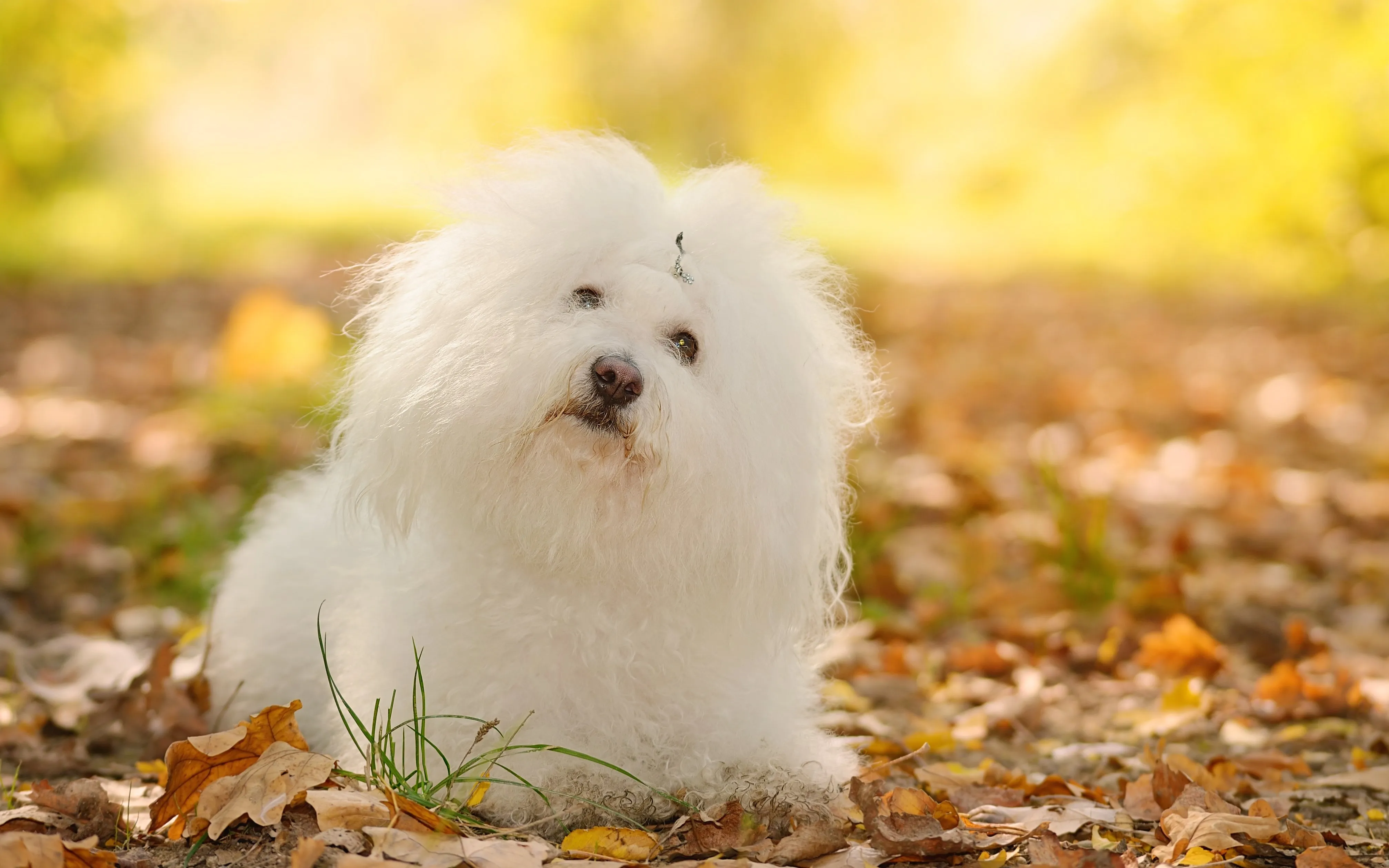 White Bolognese dog sitting in an autumn forestThe Bolognese is a charming, small breed originating from Italy, known for its long, fluffy white coat that sheds minimally. These playful and easygoing pups are devoted companions.
White Bolognese dog sitting in an autumn forestThe Bolognese is a charming, small breed originating from Italy, known for its long, fluffy white coat that sheds minimally. These playful and easygoing pups are devoted companions.
Key Characteristics: Calm, intelligent, and highly affectionate. Bolognese dogs are known for their unique temperament, often described as serious and clownish at the same time.
Grooming Requirements: Despite their fluffy appearance, their single coat requires daily brushing to prevent mats. Regular professional grooming is also recommended.
Suitability: Excellent for apartment living and families seeking a gentle, devoted companion. They typically get along well with children and other pets.
17. Maltese
 Woman holding a white Maltese dog on a bedThe Maltese is a regal yet playful toy breed famous for its luxurious, silky white coat that flows nearly to the ground. This stunning single coat sheds very little, making the Maltese a popular choice among small, non-shedding breeds.
Woman holding a white Maltese dog on a bedThe Maltese is a regal yet playful toy breed famous for its luxurious, silky white coat that flows nearly to the ground. This stunning single coat sheds very little, making the Maltese a popular choice among small, non-shedding breeds.
Key Characteristics: Gentle, affectionate, and vivacious. Maltese are intelligent and generally easy to train, thriving on companionship.
Grooming Requirements: Their long coat demands daily brushing to prevent tangles and maintain its pristine condition. Many owners opt for a shorter “puppy cut” for easier maintenance, which still requires regular brushing and professional trims.
Suitability: Ideal for apartment living and individuals seeking a devoted lapdog. They are fragile due to their small size and may not be suitable for homes with very young children.
18. Soft Coated Wheaten Terrier
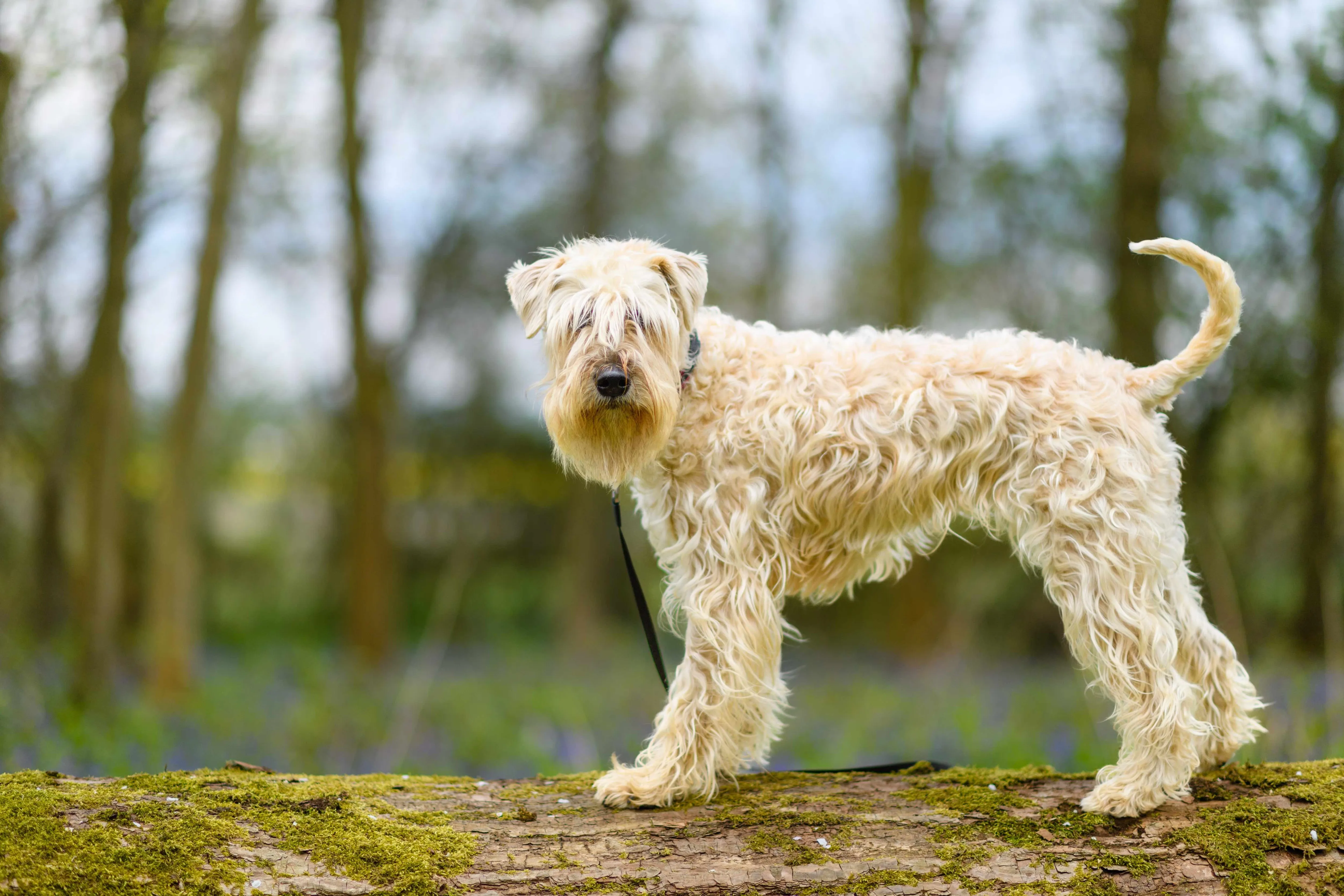 Soft Coated Wheaten Terrier dog on a logThe Soft Coated Wheaten Terrier is a medium-sized Irish breed known for its distinctive soft, wavy, wheat-colored coat that sheds minimally. They are energetic and playful, retaining a puppy-like demeanor well into adulthood.
Soft Coated Wheaten Terrier dog on a logThe Soft Coated Wheaten Terrier is a medium-sized Irish breed known for its distinctive soft, wavy, wheat-colored coat that sheds minimally. They are energetic and playful, retaining a puppy-like demeanor well into adulthood.
Key Characteristics: Spirited, joyful, and affectionate. Wheatens are known for their “Wheaten greetin’,” a joyful jump and lick to welcome people. They are intelligent and eager to please.
Grooming Requirements: Their unique coat requires daily brushing to prevent matting and professional grooming every 4-6 weeks to keep it tidy and healthy.
Suitability: Best for active families who can provide consistent exercise and mental stimulation. They thrive on human companionship and can be prone to separation anxiety.
19. Coton de Tulear
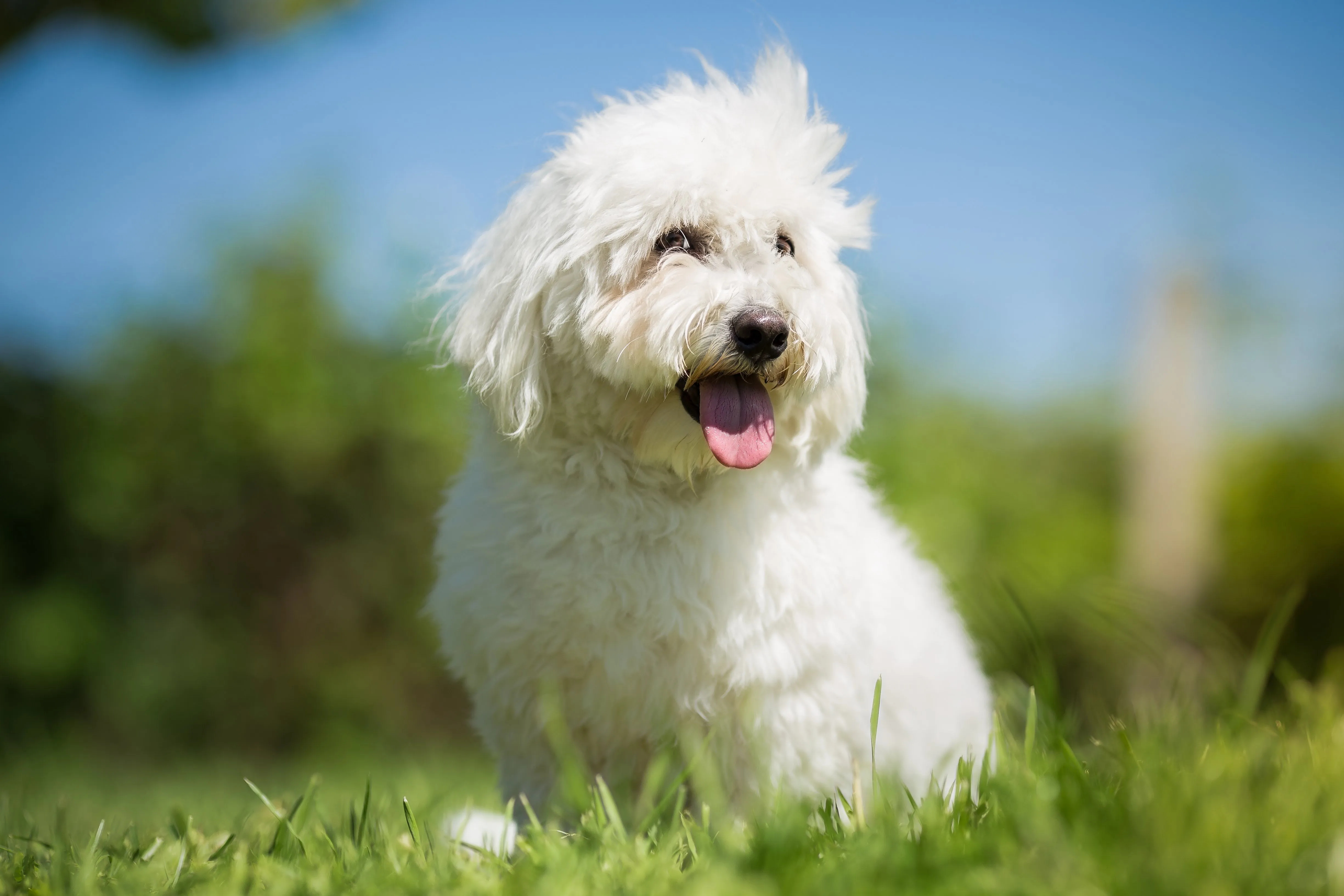 White Coton de Tulear sitting in grass with hair blowing in the windOriginating from Madagascar, the Coton de Tulear is a small, charming breed with a soft, cotton-like coat that is low-shedding. Their easygoing nature and cheerful disposition make them wonderful family pets.
White Coton de Tulear sitting in grass with hair blowing in the windOriginating from Madagascar, the Coton de Tulear is a small, charming breed with a soft, cotton-like coat that is low-shedding. Their easygoing nature and cheerful disposition make them wonderful family pets.
Key Characteristics: Playful, affectionate, and intelligent. Cotons are known for their clown-like antics and ability to adapt to various living situations.
Grooming Requirements: Their cottony coat requires regular brushing (daily to every other day) to prevent mats and occasional professional grooming.
Suitability: Excellent for apartment living and families with children and other pets. They are adaptable and thrive on being part of family activities.
20. Schnoodle
 Gray Schnoodle close-upThe Schnoodle is a designer crossbreed resulting from a Miniature Schnauzer and a Poodle—two breeds already known for their low-shedding qualities. This combination often results in a dog with a wavy or curly, low-shedding coat.
Gray Schnoodle close-upThe Schnoodle is a designer crossbreed resulting from a Miniature Schnauzer and a Poodle—two breeds already known for their low-shedding qualities. This combination often results in a dog with a wavy or curly, low-shedding coat.
Key Characteristics: Intelligent, affectionate, and playful. Schnoodles often inherit the best traits from both parent breeds, making them charming and adaptable companions.
Grooming Requirements: Their coat requires regular brushing (several times a week) and professional grooming every 6-8 weeks to prevent matting.
Suitability: Great for families and apartment dwellers, they need moderate exercise and enjoy being involved in family life.
21. Bedlington Terrier
 White Bedlington Terrier running through snowOften described as “a lamb in dog’s clothing,” the Bedlington Terrier is a distinctive breed with a unique curly, linty coat that sheds very little. They are elegant, agile, and surprisingly energetic.
White Bedlington Terrier running through snowOften described as “a lamb in dog’s clothing,” the Bedlington Terrier is a distinctive breed with a unique curly, linty coat that sheds very little. They are elegant, agile, and surprisingly energetic.
Key Characteristics: Affectionate, playful, and loyal. Bedlingtons are known for their gentle nature with family but can be tenacious when provoked.
Grooming Requirements: Their unique coat requires regular brushing and professional clipping every 6-8 weeks to maintain its lamb-like appearance.
Suitability: Good for active families who can provide consistent training and exercise. They thrive on companionship and can develop separation anxiety if left alone too often.
22. Xoloitzcuintli (Mexican Hairless Dog)
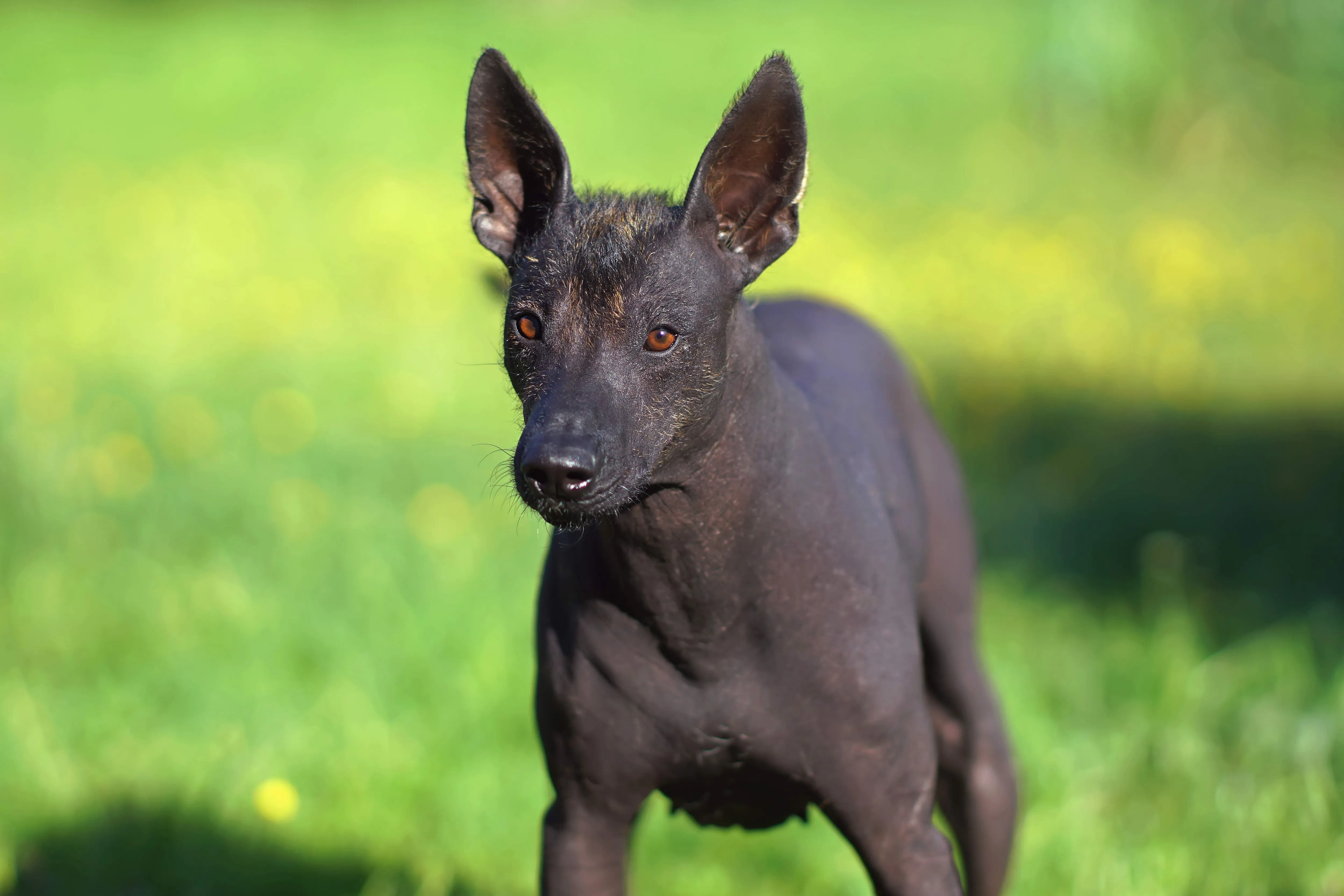 Black Mexican Hairless Dog standing in grassThe Xoloitzcuintli, or Mexican Hairless Dog, is an ancient and rare breed known for its striking appearance. They come in three sizes (toy, miniature, and standard) and two varieties: hairless and coated. Both are considered low-shedding.
Black Mexican Hairless Dog standing in grassThe Xoloitzcuintli, or Mexican Hairless Dog, is an ancient and rare breed known for its striking appearance. They come in three sizes (toy, miniature, and standard) and two varieties: hairless and coated. Both are considered low-shedding.
Key Characteristics: Calm, intelligent, and loyal. Xolos form strong bonds with their families and can be protective.
Grooming Requirements: Hairless Xolos require skin care, including moisturizing, sunscreen, and occasional bathing. Coated Xolos have a very short, smooth coat that requires minimal grooming.
Suitability: Adaptable to various living situations, but their hairless skin needs protection from extreme weather. They are good family dogs, although some can be reserved with strangers, highlighting the importance of early socialization.
23. Whoodle
 Tan Whoodle puppy dragging a washclothA Whoodle is a delightful crossbreed between a Soft Coated Wheaten Terrier and a Poodle. This combination results in a friendly, intelligent dog with a soft, wavy to curly coat that sheds very little.
Tan Whoodle puppy dragging a washclothA Whoodle is a delightful crossbreed between a Soft Coated Wheaten Terrier and a Poodle. This combination results in a friendly, intelligent dog with a soft, wavy to curly coat that sheds very little.
Key Characteristics: Affectionate, playful, and intelligent. Whoodles inherit a loving nature from both parent breeds and are known for their eager-to-please attitude.
Grooming Requirements: Their coat requires regular brushing (several times a week) and professional grooming every 6-8 weeks to prevent matting.
Suitability: Great for active families who can provide consistent exercise and mental engagement. They thrive on being part of the family and enjoy various activities.
24. Bernedoodle
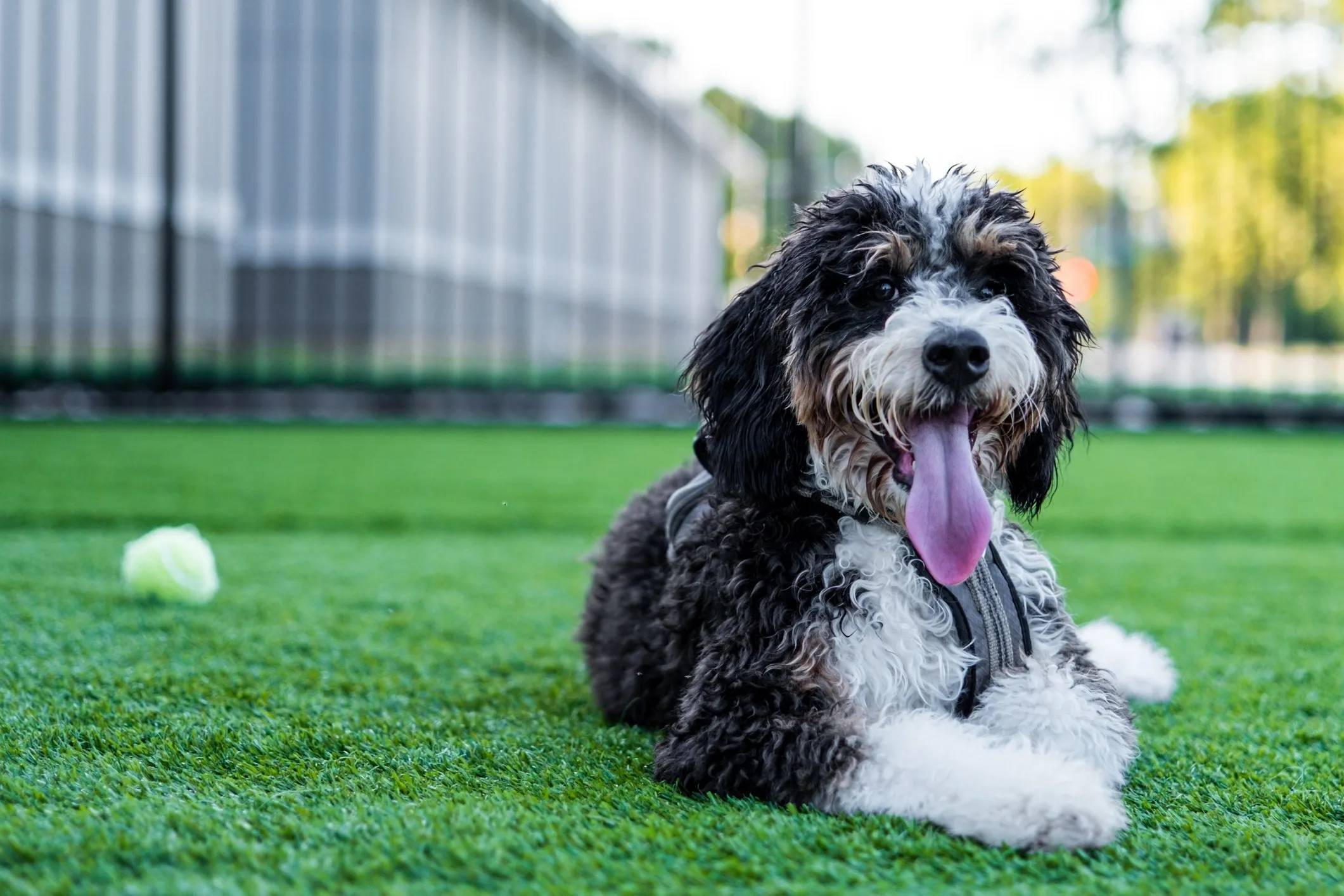 Large Bernedoodle dog lying in grass with his tongue outA cross between a Bernese Mountain Dog and a Poodle, the Bernedoodle is a large, gentle, and affectionate low-shedding breed. They combine the loyal, calm nature of the Bernese with the intelligence and coat of the Poodle.
Large Bernedoodle dog lying in grass with his tongue outA cross between a Bernese Mountain Dog and a Poodle, the Bernedoodle is a large, gentle, and affectionate low-shedding breed. They combine the loyal, calm nature of the Bernese with the intelligence and coat of the Poodle.
Key Characteristics: Friendly, calm, and intelligent. Bernedoodles are known for their gentle demeanor, making them excellent family pets, particularly with children and other pets. They are one of the [breeds of dogs that dont shed a lot] in a large package.
Grooming Requirements: Their wavy to curly coat requires regular brushing (several times a week) and professional grooming every 6-8 weeks to prevent mats.
Suitability: Best for families with ample space and time for exercise. Despite their calm nature, they need consistent physical activity to stay happy and healthy.
25. Shorkie
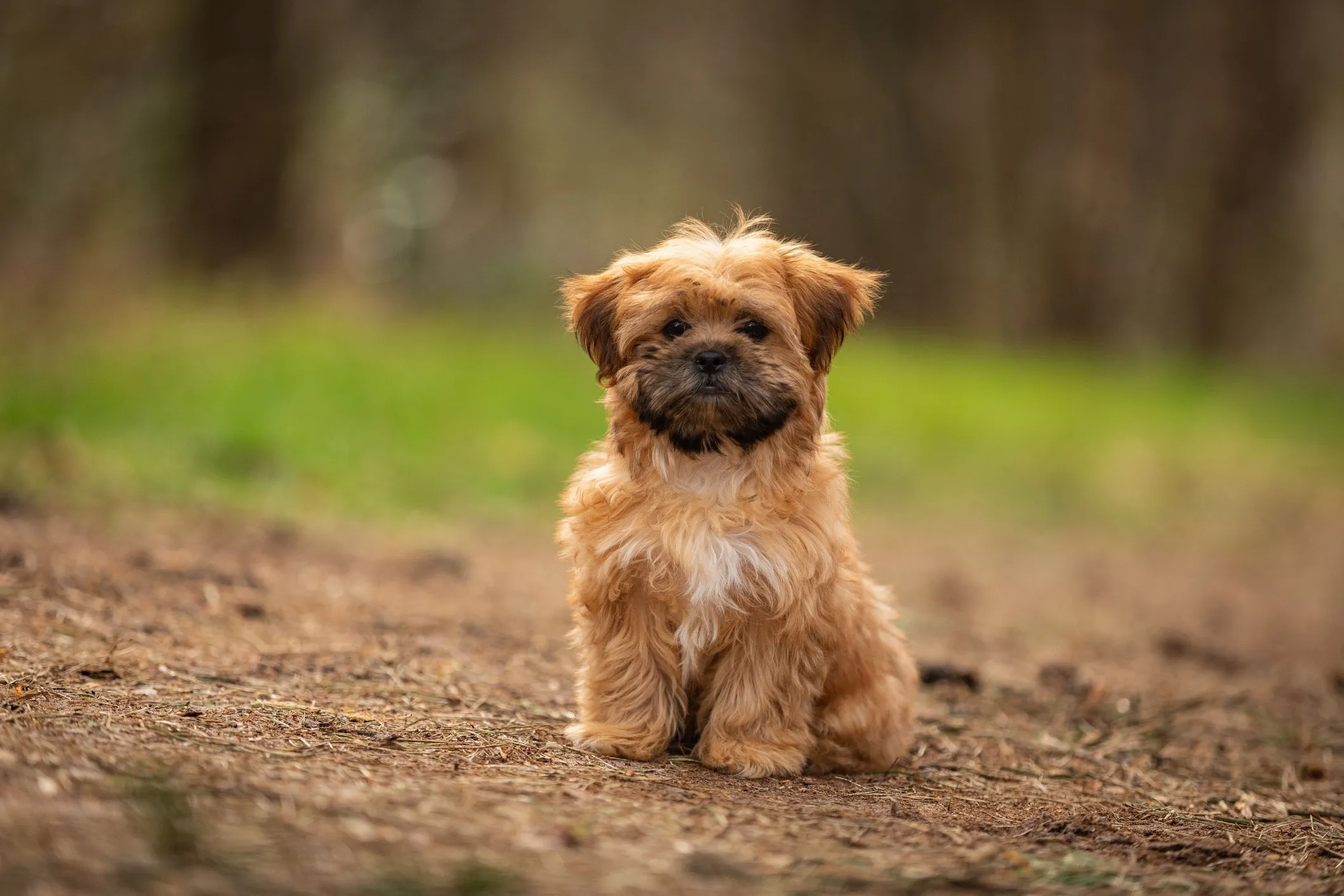 Tan and black Shih Tzu and Yorkie mix sitting on a hiking trailThe Shorkie is a charming mixed breed, a cross between two low-shedding dogs: the Shih Tzu and the Yorkshire Terrier. They typically inherit the small size, playful personality, and low-shedding qualities of both parents.
Tan and black Shih Tzu and Yorkie mix sitting on a hiking trailThe Shorkie is a charming mixed breed, a cross between two low-shedding dogs: the Shih Tzu and the Yorkshire Terrier. They typically inherit the small size, playful personality, and low-shedding qualities of both parents.
Key Characteristics: Playful, affectionate, and spirited. Shorkies are devoted companions who thrive on human attention.
Grooming Requirements: Their fine, silky coat requires daily brushing to prevent tangles and mats, along with regular professional grooming.
Suitability: Excellent for apartment living and individuals seeking a small, lively lapdog. They need consistent grooming to maintain their coat health.
26. Afghan Hound
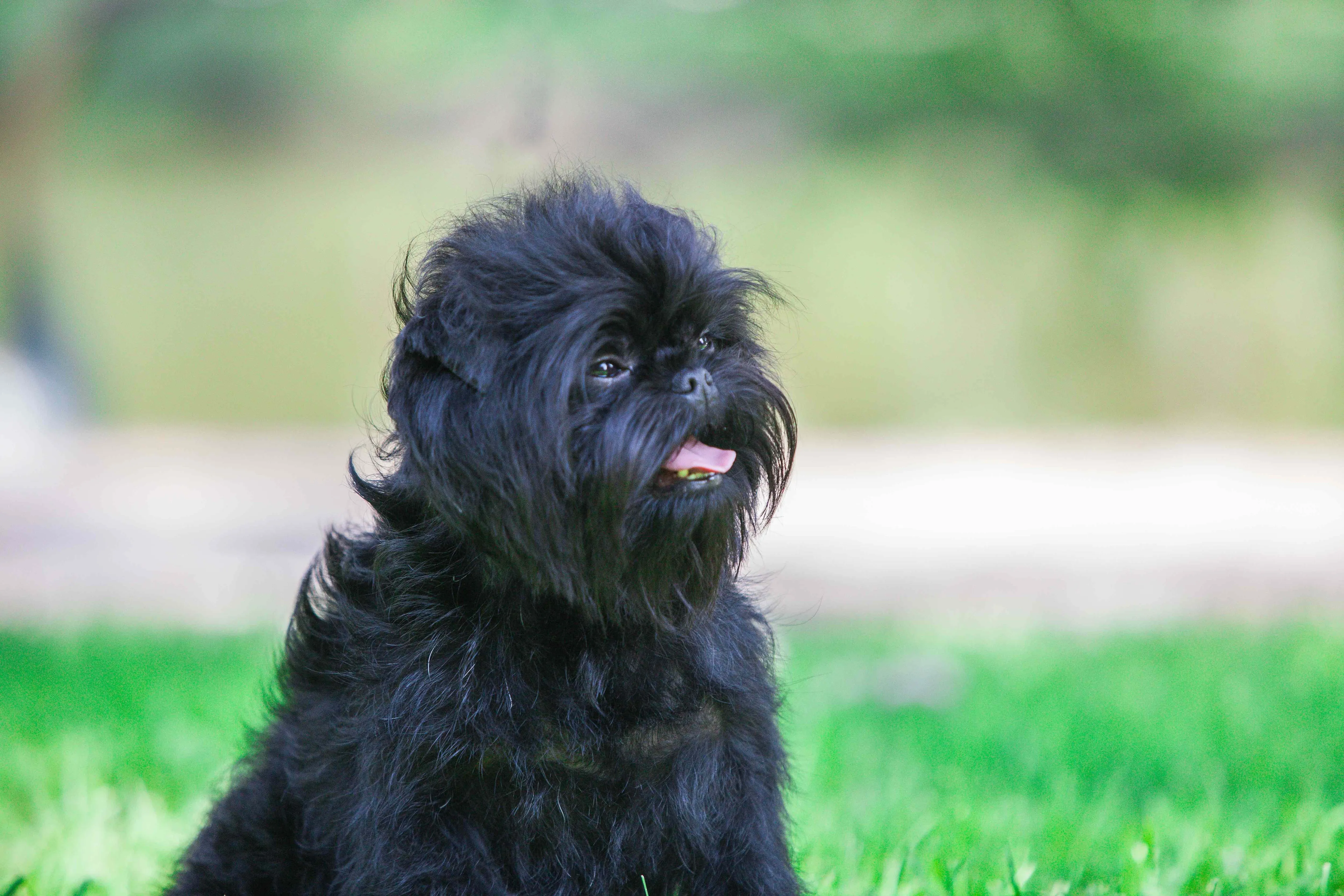 Gray and tan Afghan Hound looking at the cameraKnown for their regal appearance, long flowing coats, and distinct “ring curl” tail, Afghan Hounds are a sight to behold. Despite their abundant hair, they are considered low-shedding once their adult coat comes in, as loose hairs are often caught within the coat rather than falling out.
Gray and tan Afghan Hound looking at the cameraKnown for their regal appearance, long flowing coats, and distinct “ring curl” tail, Afghan Hounds are a sight to behold. Despite their abundant hair, they are considered low-shedding once their adult coat comes in, as loose hairs are often caught within the coat rather than falling out.
Key Characteristics: Aloof, independent, and dignified. Afghan Hounds are known for their unique personality—sweet and loving with family but often reserved with strangers. They are built for speed and endurance.
Grooming Requirements: Their exquisite, silky coat requires extensive daily grooming to prevent matting, especially after outdoor activities. Regular bathing is also essential.
Suitability: Best for experienced owners who can commit to significant grooming and provide ample exercise in a secure, fenced area due to their strong prey drive. Early and consistent socialization is vital for this breed.
27. Barbet
 Close-up of a curly red Barbet dog faceThe Barbet, pronounced “bar-bay,” is a cheerful and shaggy French water dog. Its name, derived from the French word “barbe” (beard), perfectly describes its characteristic hairy chin. Their dense, woolly, curly coat is protective in water and sheds minimally.
Close-up of a curly red Barbet dog faceThe Barbet, pronounced “bar-bay,” is a cheerful and shaggy French water dog. Its name, derived from the French word “barbe” (beard), perfectly describes its characteristic hairy chin. Their dense, woolly, curly coat is protective in water and sheds minimally.
Key Characteristics: Friendly, intelligent, and even-tempered. Barbets are eager to please and enjoy being active with their families, especially swimming.
Grooming Requirements: Their unique coat requires thorough brushing two to three times a week with a slicker or pin brush to prevent matting, particularly after swimming. Professional grooming every few months is also recommended.
Suitability: Great for active families who enjoy outdoor activities, especially water sports. They thrive on companionship and mental stimulation.
28. Shih-Poo
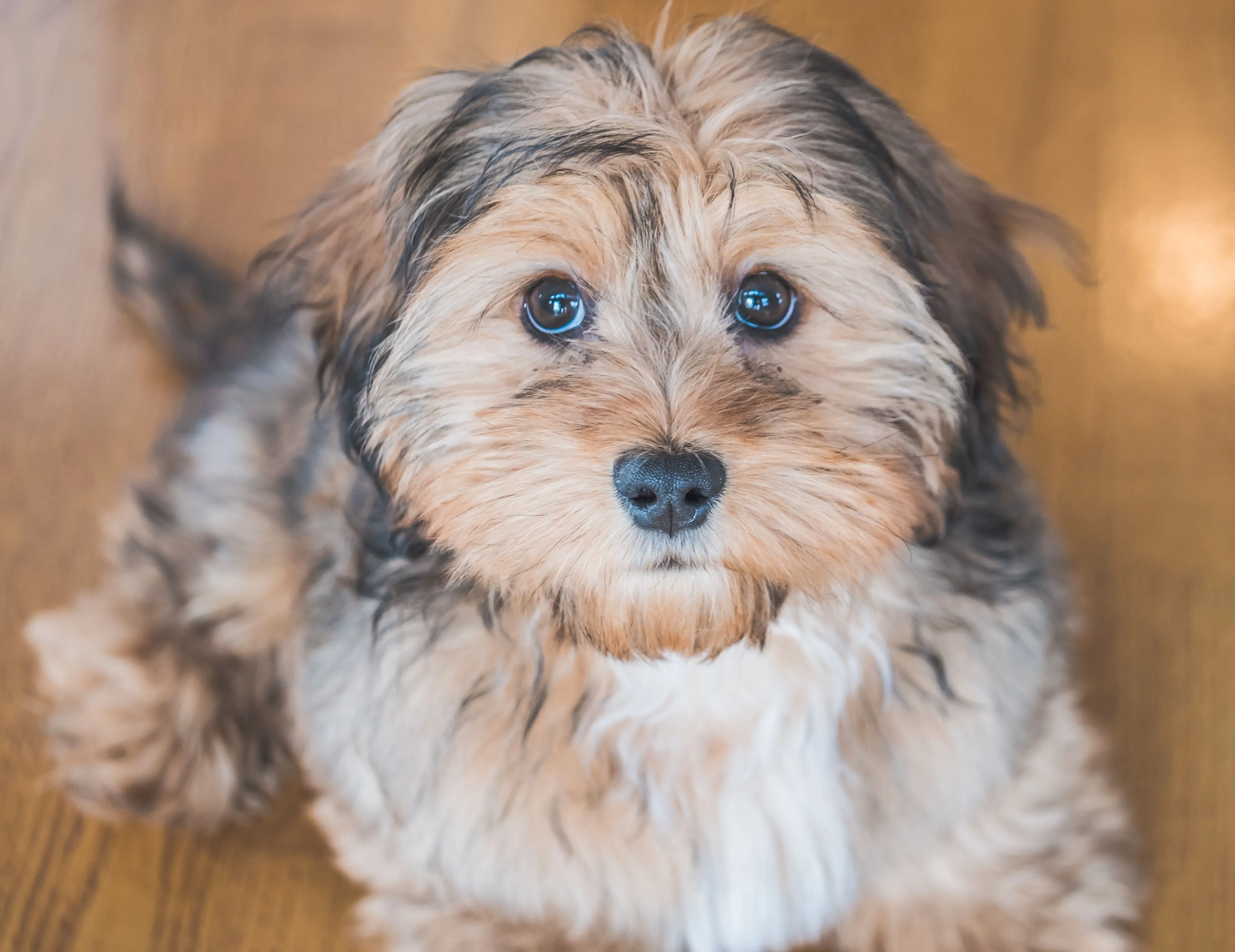 Tan and black Shih-Poo dog close-upThe Shih-Poo is a charming crossbreed typically resulting from a Shih Tzu and a Toy Poodle. This delightful mix combines the best of both low-shedding parents, resulting in a small, affectionate dog with a wavy to curly coat.
Tan and black Shih-Poo dog close-upThe Shih-Poo is a charming crossbreed typically resulting from a Shih Tzu and a Toy Poodle. This delightful mix combines the best of both low-shedding parents, resulting in a small, affectionate dog with a wavy to curly coat.
Key Characteristics: Playful, intelligent, and highly adaptable. Shih-Poos are devoted to their families and enjoy being lapdogs, thriving on human companionship.
Grooming Requirements: Their coat requires daily brushing to prevent tangles and matting, along with regular professional grooming every 6-8 weeks.
Suitability: Excellent for apartment living, seniors, and families seeking a gentle, low-maintenance exercise companion. They fit well into almost any living situation, provided they get daily attention and a moderate walk.
29. Peruvian Inca Orchid
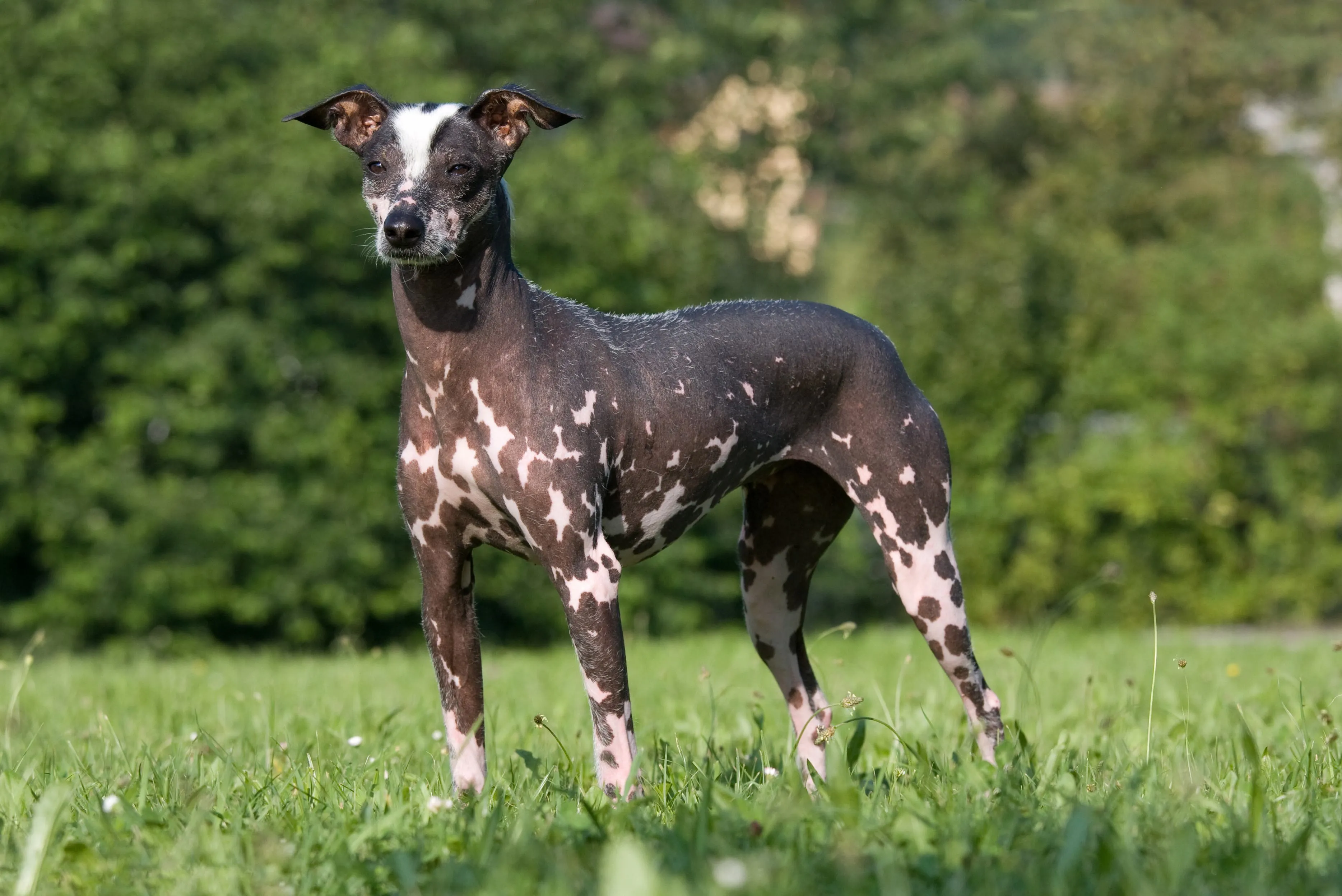 Peruvian Inca Orchid dogAs the national dog of Peru, the Peruvian Inca Orchid is a rare, ancient breed available in hairless and coated varieties, both recognized for their low-shedding qualities. The hairless variety is particularly notable for those with severe allergies.
Peruvian Inca Orchid dogAs the national dog of Peru, the Peruvian Inca Orchid is a rare, ancient breed available in hairless and coated varieties, both recognized for their low-shedding qualities. The hairless variety is particularly notable for those with severe allergies.
Key Characteristics: Agile, intelligent, and protective of their families. They can be reserved with strangers but are affectionate and loyal with their loved ones.
Grooming Requirements: Hairless varieties need regular skin care, including moisturizing and sun protection. Coated varieties have a short, single coat that requires minimal grooming.
Suitability: Suitable for owners who appreciate rare breeds and can provide a warm indoor environment for the hairless variety. They need regular exercise and mental engagement.
30. Malshi
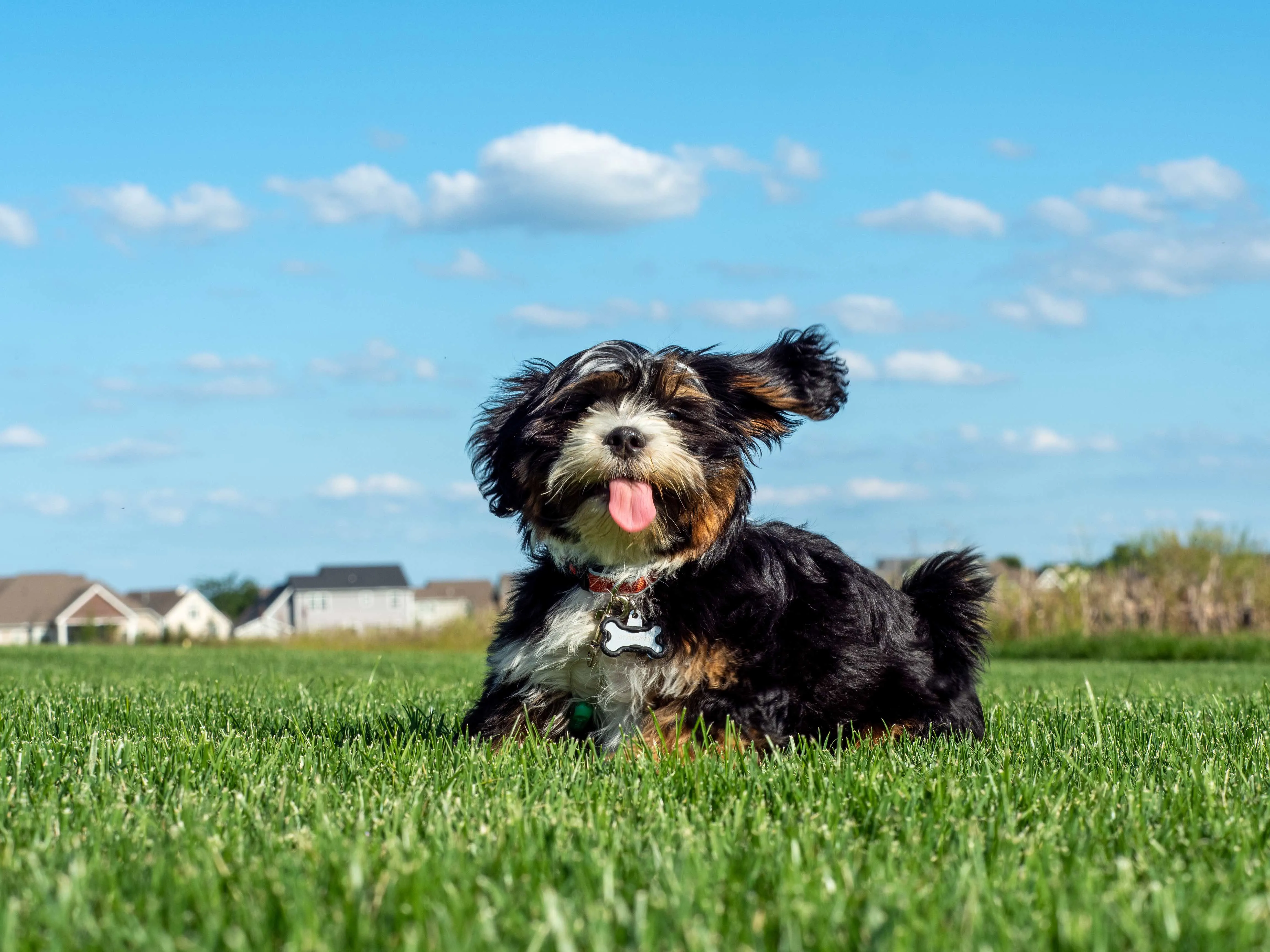 Tricolor Malshi dog in green grassThe Malshi is a sweet and gentle crossbreed between a Maltese and a Shih Tzu, combining two popular low-shedding companion breeds. This results in a small, affectionate dog with a soft, often wavy coat.
Tricolor Malshi dog in green grassThe Malshi is a sweet and gentle crossbreed between a Maltese and a Shih Tzu, combining two popular low-shedding companion breeds. This results in a small, affectionate dog with a soft, often wavy coat.
Key Characteristics: Happy, outgoing, and deeply devoted to their human companions. Malshis thrive on close interaction and love being part of family activities.
Grooming Requirements: Their soft, flowing coat requires daily brushing to prevent tangles and mats, along with regular professional grooming.
Suitability: An ideal [family dog breeds that don’t shed] that fits perfectly into apartment living and is well-suited for seniors or families seeking a loving lapdog. They need constant companionship to be truly happy.
Beyond the Breed: Essential Tips for Living with a Low-Shedding Dog
Even if you choose the best dog to get that doesn’t shed, managing allergens requires more than just picking the right breed. A holistic approach focusing on grooming, home cleanliness, and personal health is crucial for creating an allergy-friendly environment.
Consistent Grooming is Key
The primary reason low-shedding dogs are better for allergy sufferers is that their coats trap dander. This means the dander doesn’t scatter as readily throughout your home, but it does accumulate on the dog. Regular grooming is essential to remove these trapped allergens.
- Brushing: Brush your low-shedding dog frequently, ideally daily or every other day, with a brush appropriate for their coat type. Do this outdoors or in an easily cleaned area to contain any loose hair and dander.
- Bathing: Bathe your dog every 4-6 weeks using a mild, veterinarian-recommended shampoo. Some specific shampoos can help reduce dander, such as Allerpet® Dog Dander Remover. Bathing helps wash away accumulated dander and allergens from their skin and coat.
- Professional Grooming: Many low-shedding breeds require professional trimming or hand-stripping every 6-8 weeks. Factor this into your budget or learn how to groom your pup at home. This also prevents painful matting that can lead to skin issues.
Maintain a Clean Home Environment
Minimizing allergens in your living space is just as important as grooming your dog. This ensures that any allergens that do escape the dog’s coat are removed regularly.
- Vacuum Frequently: Use a vacuum cleaner with a HEPA filter on carpets, rugs, and upholstery several times a week.
- Dust Regularly: Dust surfaces with a damp cloth to capture airborne allergens rather than just redistributing them.
- Wash Bedding: Wash your dog’s bedding and your own bedding regularly in hot water to kill dust mites and remove dander.
- Air Purifiers: Consider using high-efficiency particulate air (HEPA) purifiers in rooms where your dog spends the most time.
- Designated Dog-Free Zones: Create dog-free zones, especially the bedroom, to provide an allergen-free sanctuary.
- Hard Surfaces: Opt for hard flooring (wood, tile, laminate) over carpets, which can trap allergens.
Consult Your Doctor and Veterinarian
Managing pet allergies is a personal journey, and consulting with healthcare professionals is paramount.
- Your Doctor: Discuss your allergies with your healthcare provider. They can help you develop a management plan, which might include medications (antihistamines, nasal sprays), immunotherapy (allergy shots), or other strategies to mitigate allergic reactions.
- Your Veterinarian: Your vet can advise on the best grooming practices for your specific breed and recommend hypoallergenic shampoos or dietary supplements that might improve your dog’s skin health and further reduce dander.
Consider a Trial Period or Foster
Before fully committing to a dog, especially if allergies are a significant concern, consider fostering or spending extended time with the breed you are interested in. Some shelters offer “foster-to-adopt” programs that allow you to test your allergic reaction in a real-life setting. This can provide invaluable insight into how your body reacts to a specific dog, helping you make an informed decision about the [best dog to get that doesn’t shed] for your unique needs.
Choosing a low-shedding dog can dramatically improve the quality of life for individuals with allergies, allowing them to experience the profound joy and companionship that only a canine friend can offer. By understanding the nuances of “hypoallergenic” breeds and committing to consistent grooming and home cleanliness, you can create a harmonious, sneeze-free environment for both you and your beloved pet.
References
- American Kennel Club (AKC). “Breed Information.” Available at: https://www.akc.org/dog-breeds/
- National Institute of Environmental Health Sciences (NIEHS). “Pet Allergens.” Available at: https://www.niehs.nih.gov/health/topics/agents/allergens/pets/index.cfm
- PetMD. “Dog Breed Information.” Available at: https://www.petmd.com/dog/breeds
- The American Academy of Allergy, Asthma & Immunology (AAAAI). “Pet Allergy.” Available at: https://www.aaaai.org/tools-for-public/conditions-treatments-a-z/allergies/pet-allergy
- VCA Animal Hospitals. “Dandruff in Dogs.” Available at: https://vcahospitals.com/know-your-pet/dandruff-in-dogs
